
MAY 2023 with Kentucky Explorer The Freight House’s Sara Bradley Paint Lick’s Solidago Restaurant the food issue Louisville-based Biscuit Belly Is Piping Hot 2023 Reader Recipe Contest Winners Joe Bologna’s Celebrates 50 Years Northern Kentucky Food Tours
WHERE DINING IS A MULTI-SENSORY EXPERIENCE.

Renowned for the freshest ingredients and distinctive recipes, culinary adventures throughout Kentucky invoke all of your senses.
 Anna’s Greek Restaurant, Bowling Green
Anna’s Greek Restaurant, Bowling Green
12 Selections to Savor Following a three-year hiatus due to the COVID-19 pandemic, Kentucky Monthly’s recipe contest returns with a tasty bang


18 The Baron of Breadsticks Joe Bologna’s Restaurant & Pizzeria, a legendary Lexington establishment, celebrates a milestone anniversary
Check out our accompanying supplement DRINK LOCAL for a guide to sippin’ in the Bluegrass State.


The Food Issue
24 London Calling Kentucky chef Sara Bradley competes among the culinary crème de la crème on Top Chef: World All-Stars
30 Covington’s Cuisine Scene Treat yourself to ‘speed dating for foodies’ with a restaurant tour
36 To Make Whole
A new Paint Lick restaurant celebrates the community’s agriculture and history
in
this issue 40
12 MAY ON THE COVER DEPARTMENTS 2 Kentucky Kwiz 3 Readers Write 4 Mag on the Move 8 Music 12 Cooking 47 Kentucky Explorer 58 Past Tense/ Present Tense 59 Gardening 60 Field Notes 62 Calendar 64 Vested Interest Belly Up!
the lowly
to new heights
A stack of savory biscuits from Biscuit Belly.
A Louisville couple’s restaurant chain elevates
biscuit
kentuckymonthly.com 1
kentucky kwiz
Test your knowledge of our beloved
Commonwealth. To find out how you fared, see the bottom of Vested Interest.
1. Which variety of barbecue is found primarily in Owensboro?
A. Chicken
B. Mutton
C. Pork
2. Which sandwich spread— made with mayonnaise, cream cheese and cucumber— originated in Louisville?
A. Burger Chef’s secret sauce
B. McDonald’s special sauce
C. Benedictine
3. In the Roaring ’20s, Louisville Chef Fred Schmidt created what dish to satisfy the appetites of late-night clientele?
A. The Hot Brown
B. The Brown Derby
C. The Blue Meanie
4. Harrodsburg founder James Harrod reportedly brought the tradition of asking neighbors to bring cake layers to a wedding reception to cut the parents’ costs. The number of layers indicated the popularity of the bride. The final product became known as what?
A. Bride’s Mountain Cake
B. Appalachia Apple Cake
C. Apple Stack Cake
5. Copyrighted by Kern’s Kitchen in Louisville, Derby Pie® was created in the 1950s at which popular restaurant?
A. The Beaumont Inn in Harrodsburg
B. The Melrose Inn in Prospect
C. The Toad Stool Inn in Shively
6. Compared to Irish Stew and Mulligan Stew, what dish is made of “available” ingredients and slow cooked at political picnics?
A. Roadkill Rigatoni
B. Burgoo
C. Crazy Soup
7. Celebrated at Boone Tavern and a Berea September festival, which side dish is believed to have originated from a Native American recipe?
A. Muffins
B. Biscuits
C. Spoonbread
8. In a county named for George Rogers Clark, which city hosts the Beer Cheese Festival each June?
A. Mount Sterling
B. Winchester
C. Irvine
9. This dish is served in the container in which it is baked. Patti’s 1880’s Settlement in Grand Rivers (population 400) serves more than 300,000 of them each year. Which is it?
A. Flowerpot Bread
B. Bucket Burgoo
C. Bell Jar Jelly
10. Many would say Col. Bill Newsom’s Aged Kentucky Country Hams are “to die for,” it’s appropriate that owner Nancy Newsom Mahaffey’s recipe was found written where in the late 1700s?
A. On the back of the family’s crypt in the Princeton Cemetery
B. In the old family Bible
C. In her great-great-great grandfather’s will
Celebrating the best of our Commonwealth
© 2023, Vested Interest Publications
Volume Twenty-Six, Issue 4, May 2023
Stephen M. Vest
Publisher + Editor-in-Chief
Editorial
Patricia Ranft Associate Editor

Rebecca Redding Creative Director
Deborah Kohl Kremer Assistant Editor
Ted Sloan
Contributing Editor
Cait A. Smith Copy Editor
Senior Kentributors
Jackie Hollenkamp Bentley, Jack Brammer, Bill Ellis, Steve Flairty, Gary Garth, Mick Jeffries, Kim Kobersmith, Brigitte Prather, Walt Reichert, Tracey Teo, Janine Washle and Gary P. West
Business and Circulation
Barbara Kay Vest Business Manager
Jocelyn Roper Circulation Specialist
Advertising
Lindsey Collins Senior Account Executive and Coordinator
Kelley Burchell Account Executive
Teresa Revlett Account Executive
For advertising information, call 888.329.0053 or 502.227.0053
KENTUCKY MONTHLY (ISSN 1542-0507) is published 10 times per year (monthly with combined December/ January and June/July issues) for $25 per year by Vested Interest Publications, Inc., 100 Consumer Lane, Frankfort, KY 40601. Periodicals Postage Paid at Frankfort, KY and at additional mailing offices.
POSTMASTER: Send address changes to KENTUCKY MONTHLY, P.O. Box 559, Frankfort, KY 40602-0559.


Vested Interest Publications: Stephen M. Vest, president; Patricia Ranft, vice president; Barbara Kay Vest, secretary/treasurer. Board of directors: James W. Adams Jr., Dr. Gene Burch, Gregory N. Carnes, Barbara and Pete Chiericozzi, Kellee Dicks, Maj. Jack E. Dixon, Bruce and Peggy Dungan, Mary and Michael Embry, Judy M. Harris, Greg and Carrie Hawkins, Jan and John Higginbotham, Frank Martin, Bill Noel, Michelle Jenson McDonnell, Walter B. Norris, Kasia Pater, Dr. Mary Jo Ratliff, Barry A. Royalty, Randy and Rebecca Sandell, Kendall Carr Shelton and Ted M. Sloan.
Kentucky Monthly invites queries but accepts no responsibility for unsolicited material; submissions will not be returned.

kentuckymonthly.com
2 KENTUCKY MONTHLY MAY 2023
Readers Write
The ‘E’ vs. ‘e’ Debate
My high school teacher taught lower case “e” when writing about a geographic area and capital “E” in reference to a formally recognized town or location (February issue, page 64).
The unincorporated community of Eastern, Kentucky, is in Floyd County. It has the new Floyd Central High School (replacing Allen Central and South Floyd High School) and a new public library.
Sportscaster Kenny Rice, known nationally for his horse-racing reporting, grew up in the town of Eastern.
Roger Ratliff, Pikeville
Unversity, which it originally was.
Larry Gildersleeve, Bowling Green
Finding the Way
“After reading Bill Ellis’ March article (page 58), I thought about my days coaching golf at Georgetown College. My team used to marvel at how I could always find our way to a distant match without using a GPS. I told them that I could always find my way the oldfashioned way using a MAP.
Robert “Flash” Williams, Georgetown
The Deserving Mr.
Western
As the Stomach Churns
I must comment on “A Stomach-Turning Story” by Stephen Vest in the April issue (page 64).
I laughed until I cried because I ruined poor Penny Christenson’s dress more than 65 years ago in junior high school, and the memory of the janitor, the bucket of sawdust, etc., described by Mr. Vest brought back that longhidden memory.
Bill Foree, Henry County
Ah, politics is the “damnedest” in Kentucky (as James H. Mulligan laments in his 1902 poem “In Kentucky”). Morehead should be Eastern Kentucky University, and EKU should be Central Kentucky
One of the all-time special men (Lee Robertson, February issue, page 40). Is there anyone who ever knew him who doesn’t love and respect him?
Live on my friend!
Sandra Dempsey Pettitt, Eustis, Florida
Speaking of throwing up, some of my Shelbyville Northside Grade School classmates circa 1950 still remind me of the time I threw up all over the blackboard one afternoon after a hurried lunch.
I also had the habit of throwing up during high school football practices on hot dog day, earning me the nickname “Barfin’ Bill from Snow Hill.”
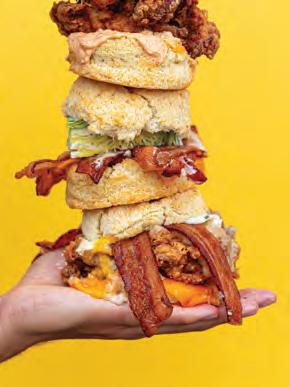
Bill Ellis, Lexington
We Love to Hear from You! Kentucky Monthly welcomes letters from all readers. Email us your comments at editor@kentuckymonthly.com, send a letter through our website at kentuckymonthly.com, or message us on Facebook. Letters may be edited for clarification and brevity.
UNITING KENTUCKIANS EVERYWHERE.
The Kentucky Gift Guide Drink Local

Counties mentioned in this issue... kentuckymonthly.com 3
• • •
• • •
Find more at kentuckymonthly.com. Use your phone to scan this QR code and visit our website. Follow us @kymonthly
This handy guide to sipping in the Bluegrass State spotlights local breweries, wineries and, of course, distilleries. Discover unique ways to drink in Kentucky, creative cocktail recipes and more.
Kentucky Monthly’s annual gift guide highlights some of the finest handcrafted gifts and treats our Commonwealth has to offer.
MAG ON THE MOVE
Even when you’re far away, you can take the spirit of your Kentucky home with you. And when you do, we want to see it!
Alaska

Cotton and Mary Ann Payton of Muhlenberg County spent a week with their grandchildren at Legoland Florida building and viewing many amazing Lego constructions such as a Lego astronaut.

Gail Deatherage and Larry Lovejoy of Warsaw recently cruised the scenic Inside Passage of Alaska.


4 KENTUCKY MONTHLY MAY 2023 travel
Amy and John Davenport of Louisville enjoyed hiking the Trail of Ten Falls in the Silver Falls State Park in Silverton Falls, Oregon.
Legoland, Florida
Silverton Falls, Oregon

Italy
Cuba
Chef Phil Dunn of Lexington (holding magazine) and Rita Smart of Versailles, Beverly Tompkins of Falcon Travel Agency (Florida) and Sue Chenault of Richmond joined central Kentuckians Brandi Mahon, Sheri Beckett and Jason, Ashley and Kendall Herndon for a week in Tuscany, Italy. Photo by Brandi Mahon of KY Real Estate Photography.

Owensboro residents Michael and Melinda Schoenwald took a weeklong educational trip from Kentucky Wesleyan University to Havana, Cuba.

6 KENTUCKY MONTHLY MAY 2023
editor@kentuckymonthly.com
A PHOTO
Scan the QR code to upload a photo, or email a high-resolution photo, along with a caption to
SUBMIT
 by Laura Younkin
by Laura Younkin
Kick Back, Have a Drink, Have Fun
Sometimes, hanging out with your buddy and drinking beer in high school can lead to trouble. Other times, it can lead to creating a band.
John Warren and Anthony Bowling met while attending Western High School in Louisville in the 1980s. “Anthony and I met in high school at the age of 16,” Warren said. “At that time, him [sic] and I were long-hairs. Walking down the halls, I’d see this long-haired, handsome guy. Warren was intrigued by Bowling.
Eventually, their paths crossed. “We’d meet up and drink. I ran into him, and we started talking,” Warren said. They discovered that they both loved Van Halen and Led Zeppelin, which led to them playing music together. Warren said Bowling was a much better guitar player than he was, so together they tried to figure out how Warren could contribute.
Bowling suggested Warren be the lead singer. When Warren told Bowling that he didn’t sing, “he said, ‘Practice,’ ” Warren recalled
Today, Warren, now of Cedar Grove (Bullitt County), is the lead singer of their band Moonshine Zombies. Bowling, who lives in Taylorsville, is the lead guitarist and produces their albums. Steve Curtsinger of Buffalo (LaRue County) plays bass, and the band is rounded out by drummer Matt Taul of Sellersburg, Indiana. Previously, Taul had played in Days of the New, a successful rock band in the ’90s.
Warren described the band’s sound as “hard rock with a Southern flair.” When reflecting on the music of his childhood, he said, “My two biggest influences are Johnny Cash and Jim Morrison.” He admired their deep, somber voices and their ability to tell a story. When considering Kentucky musicians, Warren said he has a lot of respect for the Kentucky Headhunters and Black Stone Cherry.
The Moonshine Zombies will release their as-yetuntitled third album in June or early July, according to Warren. While staying in the hard-rock genre, the band continues to experiment. “We purposely, each album, try to mix it up,” he said. He promised the new release will be different from their second album, Black Shadows. “We decide what we’re going for and write accordingly.”

Even going back to their high school days, Warren and Bowling have never been a cover band. They have written
original songs together since they were teenagers. Warren said that Bowling usually starts the song and gives Warren “something raw and demo-ish,” which he polishes.
The friends meet up and go over the song together. Warren said Bowling is always honest in his criticism if he feels the song isn’t working. “It’s never personal,” Warren said. “We’ll sit there and work it out. We work really well together.”
Their audience is always foremost in their minds when writing songs, Warren said. He sees their listeners as everyday folks who work “9 to 5 and then want an icecold beer” when they get home. “[They] go to town on Saturday and church on Sunday,” he said.
As their videos show, the band is about kicking back, having a drink, and having some fun. Warren sees music as a way to bring different types of people together. “We try to stay out of anything political or religious. We’re about uniting people,” he said.
The band hasn’t toured lately thanks to the COVID-19 pandemic and to working on albums and videos. Moonshine Zombies music is available on streaming services, and the band hopes to start playing live this summer in support of the new album. Ideally, they’d like to be the opening act for touring rock bands rather than headlining themselves.
To keep up with the band’s latest news, check out the Moonshine Zombies’ Facebook page: facebook.com/ MoonshineZombiesNation.
music
8 KENTUCKY MONTHLY MAY 2023



239.275.1717 Call for pricing & booking Cruise to Alaska celebrate our 25 th anniversary with us CRUISE INCLUSIONS 7-NIGHT CRUISE ACCOMMODATIONS MEALS ENTERTAINMENT EXCLUSIVE AMENITIES DRINK PACKAGE PRE-PAID GRATUITIES WIFI PACKAGE PRIVATE EVENTS FOR KENTUCKY MONTHLY GROUP May 2024 CRUISE EVERYTHING 239.275.1717 CALL TO BOOK kentucky monthly invites you on a cruise to alaska!
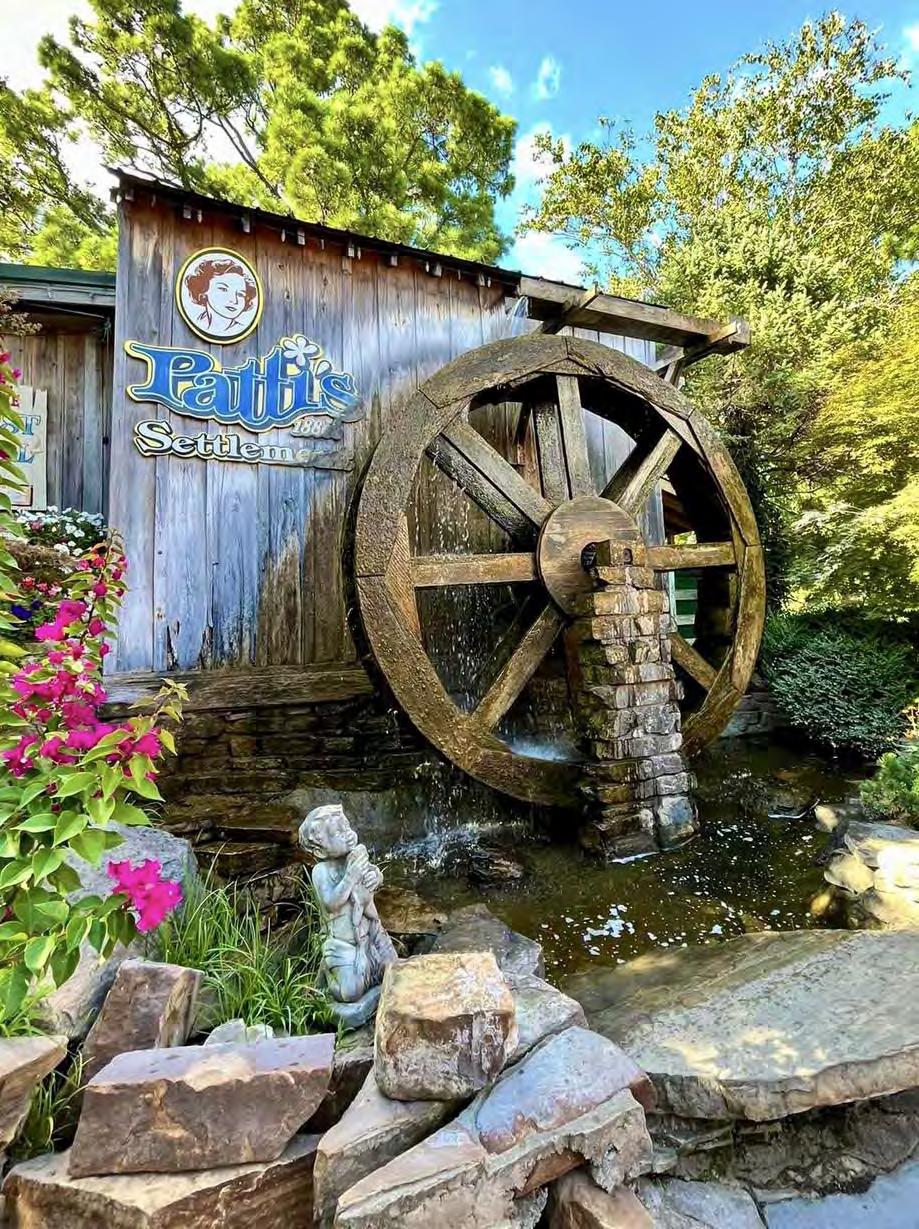


VOTED #1 Southern Living Magazine’s Reader’s Choice Award for Best Small Town Restaurant in Southeast U.S.
PATTI’S 1880’S SETTLEMENT

...where people come for a relaxing weekend, a bite to eat, a casual stroll through town, unique shopping, an afternoon of golf or sailing...and a trip back into the past. plan
a
reminder of when things moved slower...
EAT STAY PLAY
That Special Place
we recommend...



Patti’s 1880’s Settlement is that special place where friends bring friends. Patti’s and Mr. Bill’s are upscale family dining; famous for a 2” Pork Chop, Mile High Meringue Pies, Flower Pot Bread, and Strawberry Butter. Patti’s 1880’s Settlement is located in the small town of Grand Rivers, KY located at the northern entrance of Land Between the Lakes between Lake Barkley and Kentucky Lake.

pattis 1880's settlement grand rivers kentucky is western kentuckys most famous attraction as well as one of the most famous vacation destinations in the us



1793 J H O'Bryan Avenue Grand Rivers, Kentucky 42045 270.362.8844
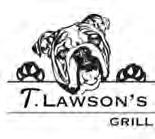
www.pattis1880s.com

Open Daily
11:00AM 8:00PM
Closed Christmas Eve, Christmas Day and the Day After Christmas.
your visit
SELECTIONS TO SAVOR
Following a three-year hiatus due to the COVID-19 pandemic, Kentucky Monthly’s recipe contest returned with a tasty bang. Prepared by our chef, Ann Currie of Sullivan University, the dishes were judged on appearance, creativity, ease of preparation, and—weighted highest of all—flavor.
Our thanks to those who entered and congratulations to the grand-prize winner and finalists!

12 KENTUCKY MONTHLY MAY 2023 cooking
PHOTOS JESSE HENDRIX-INMAN
GRAND-PRIZE WINNER
Brittany Fiero
LEXINGTON
“This colorful and flavorful salad is perfect during the hot summer months. The croutons are simple to prep and an excellent use for leftover cornbread. The arugula salad is topped with a light vinaigrette that can be made with fresh herbs from your garden.”
Arugula Salad with Peaches and Cornbread Croutons
SERVES 4
4-6 cups arugula, rinsed and dried
2 peaches, pits removed and sliced
½ cup pancetta, cubed
4 ounces goat cheese, crumbled Cornbread croutons (recipe follows) Vinaigrette (recipe follows)
For the cornbread croutons:
3 cups cubed, day-old cornbread cut into about 1-inch cubes
2-3 tablespoons olive oil
For the vinaigrette:
½ cup extra virgin olive oil
1 tablespoon honey
1 tablespoon Dijon mustard

2 tablespoons lemon juice
2-3 basil leaves
8-10 mint leaves
1 clove garlic, minced Salt and pepper, to taste
1. Preheat oven to 400 degrees.
2. In a bowl, gently toss cornbread cubes in 2-3 tablespoons olive oil. Once coated, place cubes in one layer on a baking sheet and bake for 6-8 minutes, flipping cubes throughout baking to prevent over-browning. Set aside to cool.
3. In a small pan, sauté pancetta until crispy. Drain excess oil from pancetta and allow to cool.
4. For the vinaigrette, blend together olive oil, honey, Dijon, lemon juice, basil, mint, garlic, salt and pepper in a food processor or blender.
5. Assemble salad by layering arugula, cornbread croutons, sliced peaches, crumbled goat cheese, and crispy pancetta.
6. Lightly dress salad with vinaigrette or serve on the side. Serve immediately and enjoy!
Notes: If you don’t have a blender, finely chop your herbs and whisk them into the other vinaigrette ingredients. Browning the croutons won’t take long, so flip croutons every few minutes.
kentuckymonthly.com 13
Find more Brittany Fiero recipes on her blog, hermiseenplace.com
2023 Kentucky Monthly Reader Recipe Contest
FLAHERTY (MEADE COUNTY)
Roasted Broccoli with Old Kentucky Tomme
SERVES 4-6
1 large head broccoli (1½ pounds), cut into 1½-inch florets, stems peeled and sliced ¼ inch thick
1 tablespoon Dan-O’s original seasoning
1 tablespoon McCormick Umami Seasoning with Mushrooms and Onion (can swap for any mushroom umami seasoning), plus a pinch
4 thick strips Stith Family Farms bacon
10 ounces Capriole Goat Cheese’s Old Kentucky Tomme
4 ounces cream cheese
2 tablespoons hot honey
4 teaspoons olive oil (can use Kentucky Olive if available)
Salt and pepper, to taste
1. Preheat oven to 400 degrees.
2. In a large bowl, toss broccoli florets with half the olive oil, Dan-O’s seasoning and 1 tablespoon Umami Seasoning.
3. Place florets on baking sheet and roast for 30 minutes, tossing halfway through.
4. While broccoli is roasting, fry bacon and drain.
5. Combine Old Kentucky Tomme, cream cheese and remaining olive oil with salt and pepper in a food processor. Process the mixture until creamy.
6. Remove florets from oven. They should have a slightly crunchy texture on the crown while still remaining firm but not dried out.
7. In the bottom of a large bowl or dish, place goat cheese mixture, top with roasted broccoli, and then crumble bacon over the broccoli. To finish, drizzle hot honey and add a pinch of Umami seasoning. Serve warm.
Notes: Broccoli can be breaded and fried for a softer texture. Recommendation: Kentucky Kernel breading mix.

14 KENTUCKY MONTHLY MAY 2023 cooking
FINALIST Annie Hamilton Emond
Bourbon Breakfast Casserole
SERVES 6-8

1 loaf brioche bread

6 eggs
1½ cups heavy whipping cream or Buffalo Trace Bourbon Cream Cinnamon, to taste
1 cup chocolate chips or blueberries, optional Chopped pecans, optional Maple syrup, optional Cooking spray
1. Preheat oven to 350 degrees and spray 9x13 casserole dish with cooking spray.

2. Crumble bread into small pieces and place in dish.
3. Whip eggs until smooth and add in heavy whipping cream or Bourbon Cream. Sprinkle in cinnamon and stir. Once smooth, pour over bread.
4. Top with chocolate chips, blueberries and/or pecans if using. Bake approximately 25-30 minutes. Serve with maple syrup if you like.
Note: I prefer to use the Bourbon Cream—if you don’t like bourbon, then we are probably not friends! But if you’re not a huge bourbon fan and want to cut a few calories and fat, you could split and use half-and-half with the heavy whipping cream. But trust me on the Bourbon Cream. It’s a game changer. You could also use chocolate chip brioche, bread or other flavored brioche to add extra flavor to this recipe.
FINALIST Leslie Carr
BOWLING GREEN
“My son, Trent Chappell, was home in Kentucky from the Air Force and wanted to do some bourbon tours. After we toured Buffalo Trace, I decided to put a spin on a regular French toast recipe with the distillery’s Bourbon Cream. The Bourbon Cream is a winter staple for a bunch of ladies at Indian Hills Country Club because of the late Miss Emma Jean Kirby. As soon as the weather gets cool, we all break out our Bourbon Cream for our coffee. She taught us well! This recipe is so simple, and I always get so many compliments on it. Not just for winter; you could do summer berries, too!”
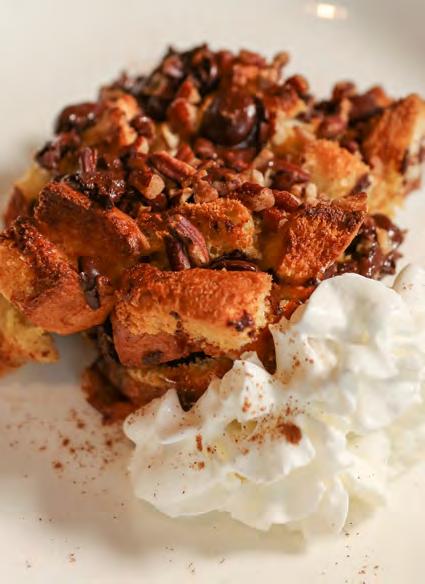
kentuckymonthly.com 15 Presents with Kentucky Shine Owensboro, KY bluegrasshall.org GA: $20 Students: $15 Sister Sadie Sister 5/18/23 | 7 PM Bluegrass Hall of Fame & Museum lostriversessions.org
Brioche
Special Thanks To

The incomparable and energetic Ann Currie for preparing the dishes; the awesome and creative Jesse HendrixInman for her delectable photos; Sullivan University for the use of one of its Culinary Arts Program kitchens; Snug Hollow Farm Bed & Breakfast for graciously providing the grand prize; and our esteemed judges Sue-Sue Hartstern, Deborah Kohl Kremer, Kay Vest and Janine Washle
MORE DELICIOUSNESS:
For additional Reader Recipe contest submissions, check out the honorable mention recipes at kentuckymonthly.com.
FINALIST
Patty Peavler
FRANKFORT
“I grew up making this spread and have modified my mother’s recipe for ease of assembly. I always use white bread cut in rounds for sandwiches, but it can be served as a dip for veggies or chips.”

Benedictine
SERVES 10 FOR SANDWICHES, MORE IF USING AS A DIP
2½ cakes cream cheese
1 heaping tablespoon chopped onion
1 slim cucumber, skinned and seeded ½ cup good mayonnaise
Shake or two cayenne pepper
3-4 drops green food coloring
1. Using a food processor, chop onion and set aside. Chop cucumber and add to onion.
2. Microwave cream cheese for 30 seconds to soften.
3. Combine cream cheese, mayonnaise, cayenne pepper and green coloring with onion and cucumber. Blend until mixture has no cheese lumps. Refrigerate. Will keep in refrigerator 5-6 days.
Notes: Benedictine sandwiches are staples at Kentucky Derby time and for showers, teas and luncheons in the Bluegrass State. My favorite mayonnaise is Duke’s, followed by Blue Plate and third is Hellman’s.
16 KENTUCKY MONTHLY MAY 2023 cooking


kentuckymonthly.com 17
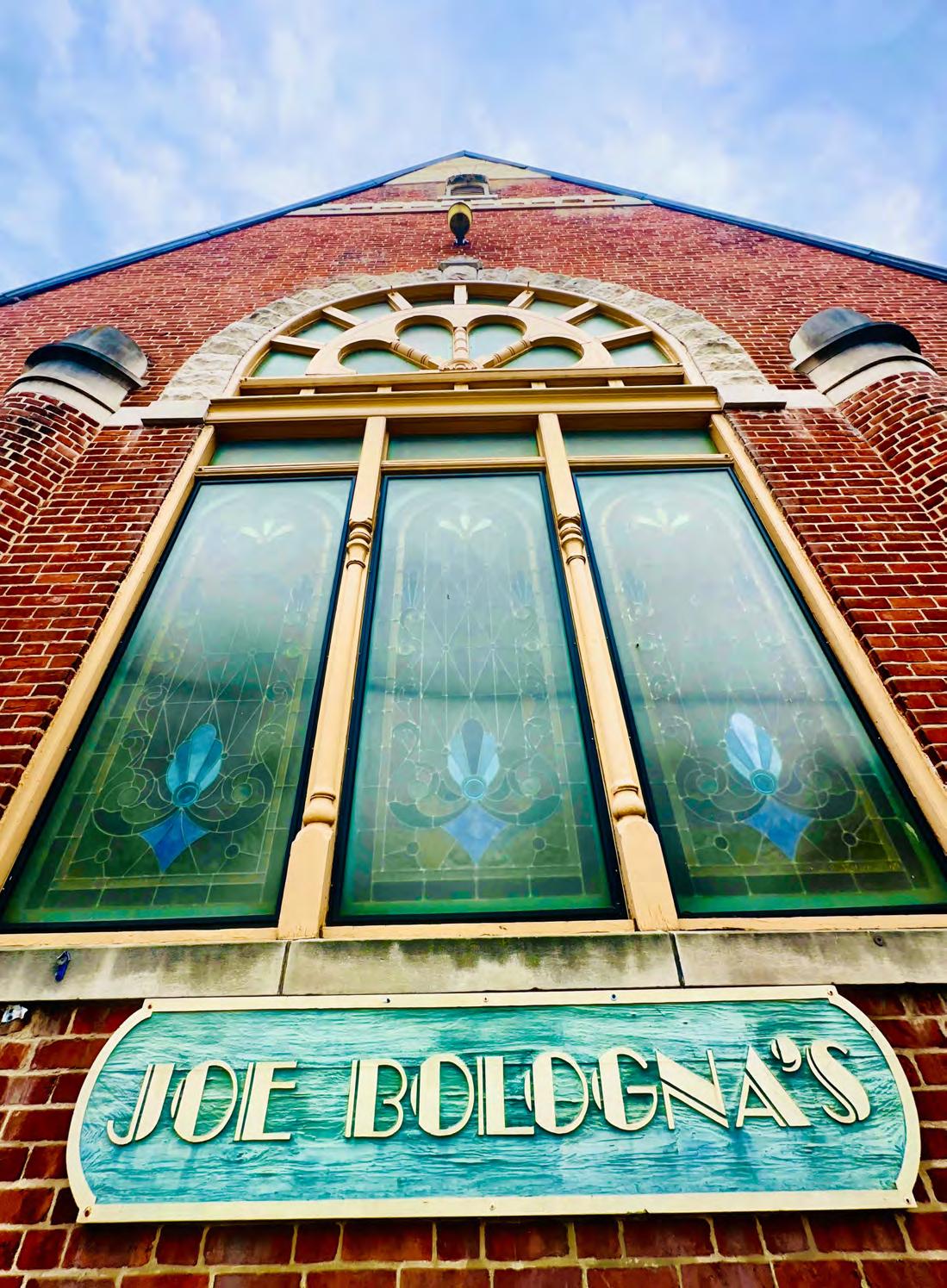
18 KENTUCKY MONTHLY MAY 2023
YOU GO: Joe Bologna’s Restaurant & Pizzeria 120 West Maxwell Street, Lexington 859.252.4933
IF
joebolognas.com
THE BARON OF
BREADSTICKS
Joe Bologna’s Italian Restaurant in Lexington isn’t famous for potato chips, and that’s a good thing. In the beginning, it could have gone either way.
When the restaurant’s namesake was considering potential appetizers, the options were breadsticks or potato chips. Bologna tested both on a friend, who bit into a warm breadstick and spoke plainly: “Joe, get those potato chips out of here.”
That was 50 years ago, when the former Air Force cook opened one of Kentucky’s most celebrated eateries, Joe Bologna’s Restaurant & Pizzeria near the University of Kentucky campus.
EARLY DAYS
The cooking part certainly wasn’t new for Bologna. “All I’ve done is cook since I was 14,” said Bologna, now a

spry 78. “I cooked in the Air Force for four years. The last year I cooked in Vietnam, it was for 3,000 soldiers a meal at Tan Son Nhut Air Base in Saigon.”
Then a funny thing happened. When a general requested an aide who could cook, Bologna went from prepping meals for 3,000 to cooking for one. That assignment had a big, if indirect, effect on Bologna’s future path. “After dinner, the general would say, ‘I love your food, and I’d like to back you in a restaurant someday,’ but he left Vietnam three months before I did,” Bologna recalled.
The seed had been planted. Bologna got another top-brass cooking assignment for another general, this time with Italian roots. “He was like my father,” Bologna said. “I wasn’t married and had ambition to open my own restaurant someday. We were talking about a steak/seafood
restaurant. Pizza really had nothing to do with it at that point.”
In the long run, neither general ended up financing the business venture, but Bologna was unfazed, even feeling it was the first general’s way of motivating him. “He liked to push people to do it on their own,” Bologna said. “He made me believe in myself.”
Bologna has spent the last 50 years cultivating an ever-growing legion of customers who believe in him. Or maybe more specifically: They believe in his handmade pizza. And his sumptuous hot breadsticks. And made-from-scratch sandwiches.
Celebrated music educator and trumpeter Vince DiMartino is a believer. “Joe and I came to Lexington about the same year [in the early 1970s]. I believe he started the culinary expansion of Lexington and contributed to the diversity of
kentuckymonthly.com 19
Joe Bologna’s Restaurant & Pizzeria, a legendary Lexington establishment, celebrates a milestone anniversary
TEXT + PHOTOS BY MICK JEFFRIES
A Lexington, KY
restaurants in the downtown area,” DiMartino said. “Personally, Joe offered the only authentic Italian food reminding me of my Long Island, New York, pizza walk-in restaurants. But most of all, he made me, and every patron, feel like part of the family.”
Which is fortuitous, because “Joe B’s” had roots in another Lexington family staple—Columbia Steak House—which was in full swing in the early 1970s with multiple locations, including at 103 West Maxwell Street, which would become the original Joe Bologna’s Italian Restaurant & Pizzeria in 1973.
Bologna says he grossed $635 the first week. “I figured I was going to starve to death,” he said. “I not only had never owned a business; I had no accounting experience.”
THE DOUGH RISES
When you’re talking Italian food, it’s all about the dough—and not just what’s in the cash drawer. Bologna’s wife, Anne, already made a winning dough that was the basis for his traditional Sicilian deep-dish pizza as well as the famous breadsticks, which were modeled after those served in his hometown of Detroit, with delectable garlic butter on the side.

Bologna surveyed the Lexington restaurant scene, such as it was in the early ’70s. “I went all over Lexington
and tried every kind of pizza that was made. Everything was frozen, and they used cheap products,” he said.
Fortunes soon improved with the arrival of a particular clientele: college students, whom Bologna quickly embraced. “It definitely became the ‘college place’ in the ’70s and ’80s. Before that, our lunch customers were all businesspeople from downtown. A college student wouldn’t even come into the place,” he said.
One such customer was UK Associate Professor of Multimedia Kakie Urch. “When I was in college in the late ’80s, Joe Bologna’s was almost always the right answer for: ‘Where are we going to eat?’ ” she said. “The food was fresh and delicious; the atmosphere was open and casual. You were likely to see your classmates, professors, administrators or city leaders have a meeting meal, a celebration meal, or just a quick lunch. There were many sessions of strategy for our college radio project, WRFL-FM, at Joe B’s, tossing ideas about while dipping breadsticks or folding pizza.”
“The atmosphere was created by the customers themselves,” Bologna said. “I didn’t try to make it anything. We were a casual place.”
That wasn’t the norm in the early 1970s, when Lexington’s fabled eating spots like Stanley Demos’ Coach
House had a semiformal dress code. Not so with Joe Bologna’s Restaurant. “We were not ‘fine food,’ but we were good food and good service. A clean place with a simple philosophy,” Bologna said.

BRANCHING OUT + CROSSING THE STREET
The approach was a hit, and business was so good that, during the ’70s and ’80s, Joe Bologna’s had three Lexington locations and a delivery business that worked until it didn’t. “I had a general manager at the time who convinced me to go out Richmond Road, but that place lost me $350,000 over seven years,” Bologna recalled. “If it wasn’t for the little place here making so much money … I broke even for the whole seven years!”
Fond memories abound for the original Joe B’s location, at the corner of South Limestone and Maxwell streets. It was small. The capacity claimed to be 70, though packed-in regulars might raise an eyebrow at that high number.
Retired UK music professor Ron Pen said it was his first meal out when he moved to Lexington for graduate school, and he fell in love. “[It] looked and acted exactly as a pizza dive in a college town should: suitably dark, intimately cramped
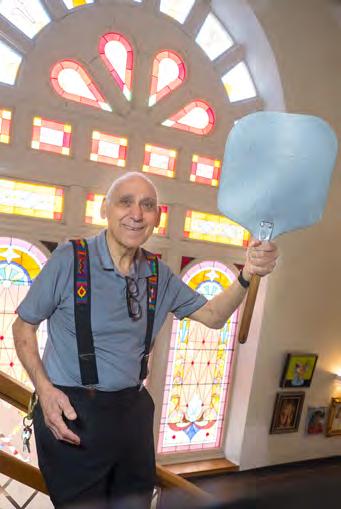
20 KENTUCKY MONTHLY MAY 2023
Since 1973
Favorite
“I’ll always remember the time Joe prepared pizza for a large group we were hosting away from Joe Bologna’s. We also have enjoyed going to dinner with two specific groups of friends at Joe B’s—traditions! He is a dear man.”
 Lexington Mayor Linda Gorton
Lexington Mayor Linda Gorton
“I worked as a pizza chef for Joe. In those days, we used a real pizza oven. I do believe I still have a couple of scars on my arms to show for it. Joe’s skills as a boss were filled with poise and grace. Kindness, it seems, was the key to getting hard work from your employees … To this day, it’s still possible to get one of the most authentic Italian meals in Lexington at Joe Bologna’s. And if you’re lucky enough, you’ll see Joe with his eternal smile and everpresent desire to share some delicious cuisine.”
 Mike Graves, WUKY-FM “Rock-n-Roots” host
Mike Graves, WUKY-FM “Rock-n-Roots” host
“I used to love the Sicilian pizza there. And when we were young teens and given free roam on our dirt bikes, we used to go to Joe B’s for breadsticks and a side order of banana peppers. Total cost for lunch: approximately $1.50. I’m sure the lunchtime servers loved us. Great times!”
Eli Kay-Oliphant, Chicago
“One Sunday night, I was in Zandale in my laundromat, and this guy who walked in was pitiful looking. And he introduced himself. He said he was thinking of opening the best Italian restaurant in Lexington and was thinking of calling it ‘Joe Baloney’s.’ I told my wife and thought, ‘There’s no way this guy is gonna make it.’ … [Joe and I have] been close for 50 years.”
Denny Williamson, longtime Lexingtonian
“Yes! I know Joe …”
“Through the decades, I have turned and returned to Joe B’s and have always enjoyed every meal, every moment, regardless of the world outside. This is a special oasis—a place outside place, a time outside time, nirvana in Lexington. Thank you for this gift to Lexington, Joe.”
Dr. Ron Pen, retired University of Kentucky music professor
kentuckymonthly.com 21
“ ”
Welcome to Joe B's!
booths, boisterous and gregarious inhabitants,” he said.
A bigger space was on the horizon, though, motivated by a looming rent hike, which seemed unfair to Bologna and his bustling business. “I felt the place never would have had the success without the work we were doing, so I figured I should not pay more because I was successful,” he said.

In August 1989, after 16 years in the original spot, Joe Bologna’s Restaurant found a new home right across the street. The space was in a historic building that had begun life in 1891, serving first as a Presbyterian church and later a synagogue. Both of those congregations had outgrown the space. It was a great match for Bologna, more than doubling the seating capacity and adding the charm of 18-foot-tall stained-glass
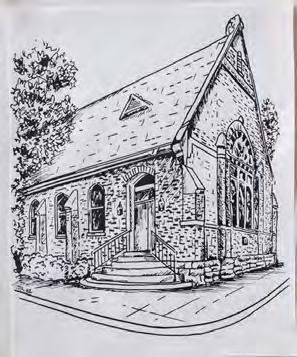
windows, soaring ceilings and original hardwood flooring.
RISING TO ECONOMIC CHALLENGES
Bologna has had his share of challenges in the restaurant business—the 1992 and 2008 recessions and the COVID-19 pandemic being among them. In 1992, Bologna was told that he needed to cut $10,000 a month from the budget to make up for a 20 percent drop in sales just to break even. “So, I laid off two managers. I took a 20 percent cut in pay and went back to working 16 hours a day. You do what you got to do to survive,” he said. “After the 2008 recession, I lost money for eight years straight. And I was just getting to break-even and starting to make money again when the pandemic hit.”



22 KENTUCKY MONTHLY MAY 2023
Top, artwork of the Joe Bologna’s Restaurant & Pizzaria space from its days as a place of worship; second from top, Bologna shows off one of his famous pizzas in December 1979 [courtesy of the Lexington Herald-Leader]; second from bottom, Bologna in 1987 [courtesy of the Lexington Herald-Leader]; bottom, Bologna (center) and crew continue to provide catering services.
Bologna said he went from $350,000 in the bank to $25,000.
The COVID-19 pandemic would have been the restaurant’s swan song without support from the federal Paycheck Protection Program (PPP), which floated Bologna $850,000 in forgivable loans. “You didn’t know where it was all going to end—it lasted three years,” he said. “If the PPP money hadn’t been totally backed by the government, I’d have been bankrupt.”


LOOKING AHEAD
After 50 years, both the man and the restaurant seem to be going strong, undaunted. Part of the explanation for the longevity of Joe B’s is surely Bologna himself, who proudly proclaimed: “I like work.” And work he does, usually four-five shifts a week, circulating throughout the back and front of house, doing whatever needs doing, though he confesses it’s harder now that he’s in his 70s than it was when he was younger. “But I can still go back and do whatever I gotta do in the kitchen if I have to,” he said.
Especially critical to the restaurant’s success is a solid staff. “You try to find people with good teamwork, whether it’s in front or the back. You’ve got to be compatible with everybody,” Bologna said.
Through it all, Bologna is grateful for a rewarding and lengthy career. “I got to do what I love doing. Not only had I not planned on being around 50 years, I didn’t plan on it being as successful as it was. I think that we try to just do the same thing we’ve always done,” Bologna reflected. “We don’t try and change things; we just make them the same way people expect to get them every time. I could put a prime rib special out there and have nobody buy it because they know what they want when they come here.”
Which can be a funny predilection but a fun challenge for Joe Bologna. “I had a guy that came in for 13 years and ordered nothing but zucchini parmesan. I finally made him a pizza. And he started getting different things,” he said.
“I stand behind everything that we make—it’s going to be good.” Q
kentuckymonthly.com 23
danvillekentucky.com
for the entire
1–4, 2023 Join Us for the 33RD ANNUAL
The Great American Brass Band Festival is a FREE event held annually in beautiful Danville, Kentucky on the campus of Centre College and downtown Danville. Enjoy brass band music, great food & drink, picnics, and parades.
Fun
family! June
LONDON CALLING
THE FREIGHT HOUSE
330 SOUTH THIRD STREET PADUCAH
270.908.0006
FREIGHTHOUSEFOOD.COM
BY TRACEY TEO
When Sara Bradley was a student at the University of Kentucky, she approached a Lexington restaurant owner and asked if she could work in the kitchen, not to pick up extra cash, but because she had a genuine interest in gastronomy and was considering culinary school. The owner agreed to take her on for an
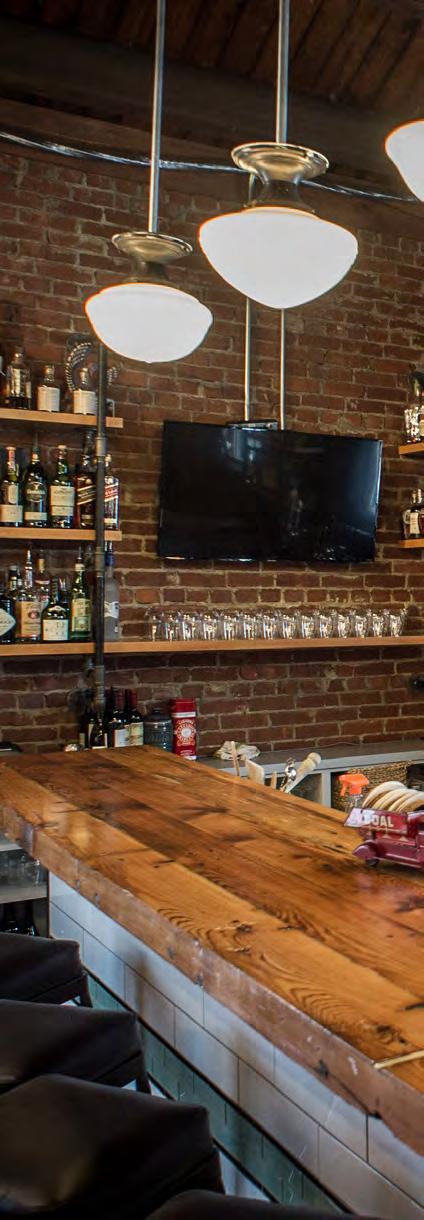
afternoon. Bradley was excited by the prospect of learning knife skills and bread-making techniques from a team that turned out top-notch cuisine.
The reality fell far short of Bradley’s expectations. The restaurant served machine-cut frozen vegetables, and the bread came out of a box. She was deeply disappointed but gave it her best shot.
At the end of the day, the owner
broke the bad news: Bradley just didn’t have what it took to make it in the restaurant industry.
That was 20 years ago. Today, Bradley is a celebrity chef who recently competed on Top Chef: World All-Stars, Bravo’s reality cooking show, and she is the chef and proprietor of The Freight House, a restaurant and bourbon bar in Paducah, her hometown, that marries her father’s
24 KENTUCKY MONTHLY MAY 2023
Kentucky chef Sara Bradley competes among the culinary crème de la crème on Top Chef: World All-Stars
Appalachian roots with her mother’s Jewish heritage. A graduate of Johnson & Wales, a prestigious culinary school in Charlotte, North Carolina, she’s had knife skills under her belt for years.
“When things got hard in culinary school, I would picture that man telling me I don’t have what it takes,” Bradley said. “It was really a force in the beginning of my career.”
As a finalist on Top Chef: Kentucky in 2019, Bradley was one of 16 chefs chosen to compete on Top Chef: World All-Stars, which premiered March 9. Season 20 is a sort of culinary Olympics that includes winners and finalists from 11 Top Chef spinoff shows from around the world—the crème de la crème of previous “cheftestants.”



The winner takes home $250,000.
Filmed mainly in London, this
season marks the first time the flagship edition of Top Chef has been set entirely outside the United States. The finale takes place in one of the world’s great food cities—Paris.
In each episode, contestants compete in a quickfire challenge followed by an elimination challenge. Bradley was a champion right out of the gate, winning the quickfire challenge on episode one.
kentuckymonthly.com 25
EVERYTHING SALAD
SERVES 10-12
1 head iceberg lettuce, thinly sliced
2 cups finely shredded cabbage

1 cup green grapes, quartered
6 radishes, thinly sliced
¼ cup capers, roughly chopped
1/3 cup pickled red onion
Salt and pepper to taste
1 cup cream cheese dill dressing (you may need more dressing, depending on the size of the lettuce head)
1 cup everything puffed rice
Cream Cheese Dressing
8 ounces cream cheese, cubed and softened
1 cup buttermilk
1 tablespoon fresh dill fronds, chopped
1 teaspoon granulated garlic
1 teaspoon granulated onion
1 teaspoon sugar
1 tablespoon kosher salt
1 tablespoon fresh cracked black pepper
1. In a food processor, whip the cream cheese until smooth. Add all other ingredients and process until smooth.
2. Chill until ready to use.
The challenge kicked off with the chefs scrambling to fill their shopping baskets with five ingredients from the Top Chef kitchen in three minutes, with no idea what they would be asked to cook.
They soon learned seafood was on the menu, but host Padma Lakshmi introduced a twist. The contestants had to combine their ingredients with those of another chef, and each team had 30 minutes to prepare something tantalizing enough to wow the refined palates of Lakshmi and her fellow judges—chef Tom Colicchio and food writer Gail Simmons
Bradley’s partner chef was Dale MacKay, winner of the first season of Top Chef Canada in 2011. Fortunately, the pair had ingredients that worked well with seafood. They triumphed with delicately cooked langoustine topped with zesty gremolata, a simple Italian condiment made with lemon, garlic and parsley.
That meant Bradley and MacKay were safe from elimination on the premiere episode.
“Immunity on the first episode is the best one you can win all season long because nobody wants to be the first chef to go home,” Bradley said.
Technically, eliminated chefs don’t go home. They are required to stick around for the entire eight weeks of filming so as not to give away who has been eliminated before all the episodes are filmed.
It was hard for Bradley to be away from husband Austin Martin and their daughters, Lula, 4, and Hazel, who was only 9 months old when Bradley traveled to Europe last summer. The only consolation was that all the chefs were in the same boat.
“There was a ton of bonding going on. It was sort of like summer camp for chefs,” Bradley said. “Right away, I bonded with Sylwia from Poland and Nicole from Canada. Sylwia and I have daughters around the same age, and we are in about the same place in our careers.”
Having a baby back home in Paducah meant Bradley had an extra responsibility—pumping breast milk and shipping it across the pond.
“As a chef, it’s our job to feed people,” Bradley said. “I shouldn’t have to choose between feeding my daughter or being a chef.”
Since becoming a mom, Bradley’s outlook on work/life balance has shifted dramatically.
“My whole mindset about how a chef should be with their staff changed,” Bradley said. “I think that we have to be respectful that life happens outside of the restaurant, so we accommodate people when they can’t be here because they are sick, or their child is sick. That hasn’t always been the mentality in the restaurant industry.”
There was a time when sick restaurant workers were expected to show up and power through, but the COVID-19 pandemic turned that idea on its head because working sick meant endangering the livelihood of coworkers and the well-being of customers.
When Bradley’s not in the kitchen, she likes puttering around her home garden, where she grows everything from arugula to pumpkins. She’s a big believer in companion planting, a natural way to reduce pests without chemical pesticides. For instance, basil planted near tomatoes helps prevent tomato hornworms that can munch their way through a garden faster than you can say, “suffering succotash.” Daughter Lula helps pick the plump red tomatoes. She’s learned the green ones need a little more time in the sun.
A Toad in the Hole and Bangers and Mash
On episode three of Top Chef, contestants went on a pub crawl, drinking pints and tasting traditional pub dishes like toad in the hole (sausages baked in Yorkshire pudding batter) and bangers and mash (sausages with mashed potatoes). Afterward, they were tasked with cooking some of the foods they had sampled for a doubleelimination challenge.
Bradley’s favorite was shepherd’s pie, a savory pie of ground lamb topped with mashed potatoes. She and German chef Tom Goetter sailed through the challenge with a reimagined version of this classic British meal that sometimes appears on the menu at The Freight House.
While some of these dishes may be unfamiliar to Kentuckians, Bradley said there are numerous
26 KENTUCKY MONTHLY MAY 2023
Continued from preceding page.
Everything Puffed Rice
½ tablespoon dried, chopped garlic
½ tablespoon dried, chopped onion
½ tablespoon black sesame seeds
½ tablespoon white sesame seeds
½ tablespoon celery seed
½ tablespoon poppy seed
½ cup puffed rice (recipe follows)
½ cup bagel chips, crushed
Mix together all ingredients and store in an airtight container.
Puffed Rice
1 cup vegetable oil
¼ cup long grain rice
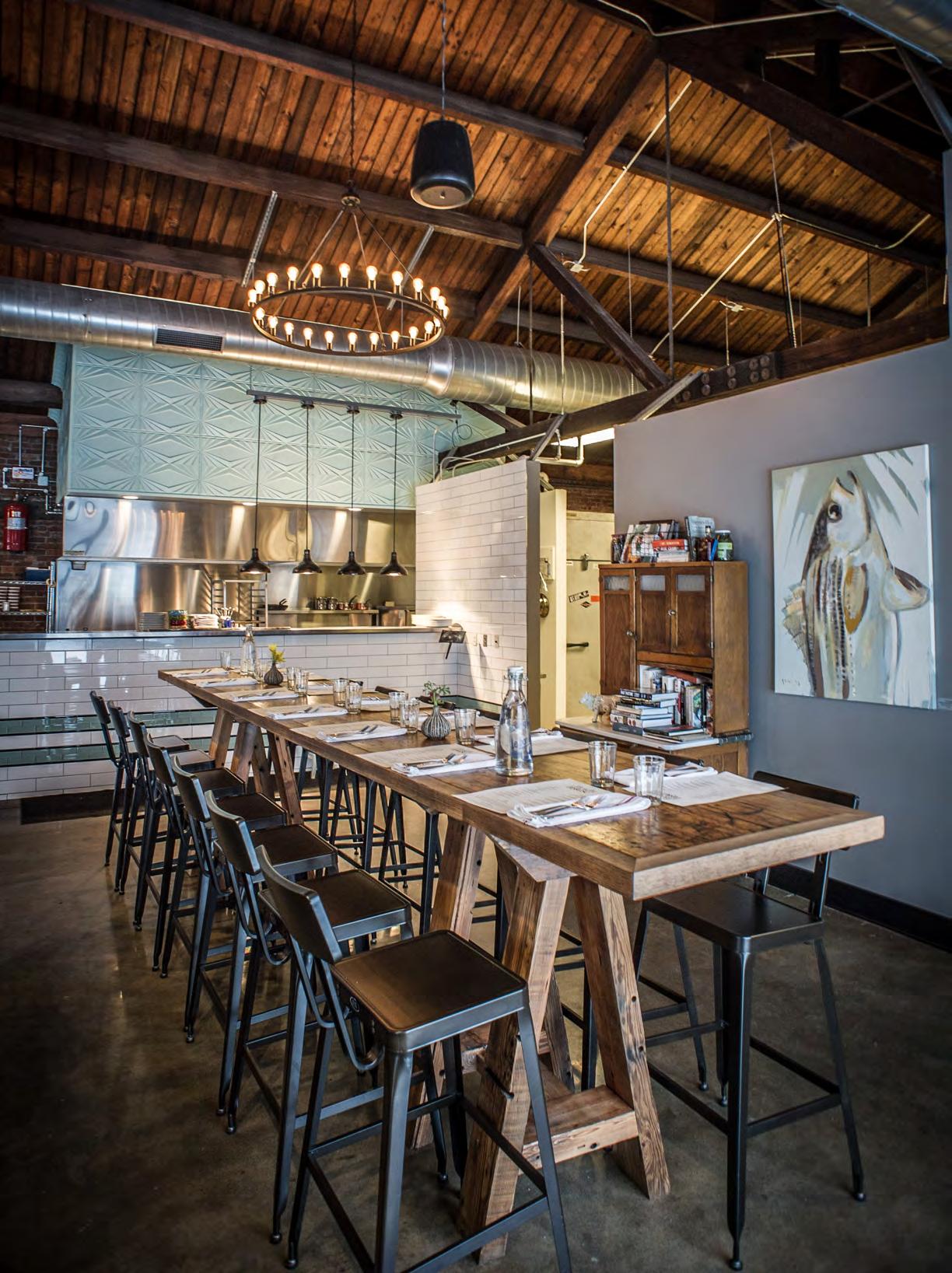
1. Prepare a pan lined with paper towels. Have a separate container to pour hot oil into and have a small strainer ready.
2. Heat oil in a pan on top of the stove to 425 degrees.
3. Add dry, uncooked rice and stir. Let cook for 10-20 seconds or until you see it puff. Do not burn!
3. Pour the rice and oil through the strainer, allowing oil to collect in the extra vessel.
4. Drain rice on paper towels. Mix with everything spice when cool.
Final Assembly
Mix together all salad ingredients except puffed rice, which gets sprinkled on top as the final step.
Recipe courtesy of Sara Bradley, chef/proprietor of The Freight House in Paducah.
similarities between traditional Kentucky fare and British food because many of Kentucky’s early settlers emigrated from England, Ireland and Scotland. They brought their culinary traditions with them.


“That’s why mutton is such a big thing in western Kentucky. There were lots of shepherds here,” Bradley said.
Fish and chips, an English pub staple, has its Kentucky counterpart—the fish fry. Kentuckians love the big social gatherings starring crunchy fish with a side of coleslaw. The Freight House serves fried fish every Friday to accommodate Catholic customers— and because it’s delicious.

Scotch eggs are another popular British pub bite that occasionally make an appearance at The Freight House. People come from miles around to tuck into the sausagewrapped eggs that are breaded and deep fried to crispy perfection.
Unfortunately, this dish was the downfall of MacKay and his partner,


May Thongthong of Thailand. The judges deemed their Scotch egg to be lacking in crunch, and they were given the dreaded order, “Pack your knives and go.”
Looking to the Future
What’s next for Bradley? Many chefs dream of chic Michelin-starred restaurants and James Beard awards, the ultimate recognition in American culinary arts circles. Bradley would welcome the accolades, but they don’t define her success.
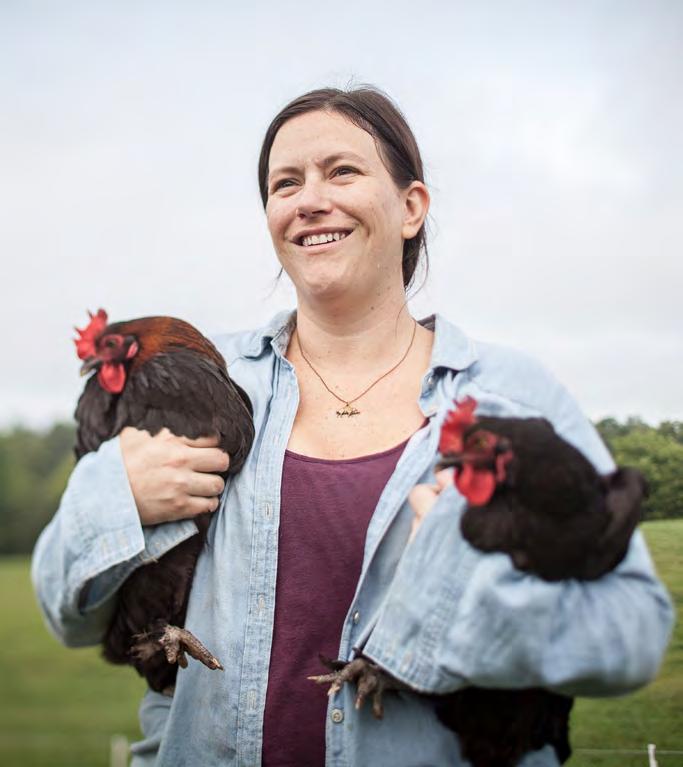
“Early in my career, I wanted a James Beard Award—and I still want one—but now, I don’t need everyone’s praise as much as I thought I did before,” Bradley said. “And what we do at the restaurant is beautiful, with or without a Michelin star.”
Another restaurant could be on the horizon, and she hopes to write a cookbook someday. For now, her priority is making time to pick tomatoes with Lula—but only the
28 KENTUCKY MONTHLY MAY 2023
Find The Freight House on Facebook to see more of their delicious dishes. Scan the QR code above to visit their website for a complete menu and more.
Explore infinite possibilities.
Experience high school differently. The Gatton Academy of Mathematics and Science offers gifted and talented high school juniors and seniors in Kentucky a chance to start college while finishing high school at Western Kentucky University. This two-year residential STEM program allows students to participate in college coursework full-time, pursue faculty-mentored research, study abroad, and thrive in a supportive community. With scholarships covering tuition, housing, and meals, students at Gatton can explore their interests in STEM. Explore your infinite possibilities at www.wku.edu/academy. wku.edu/academy
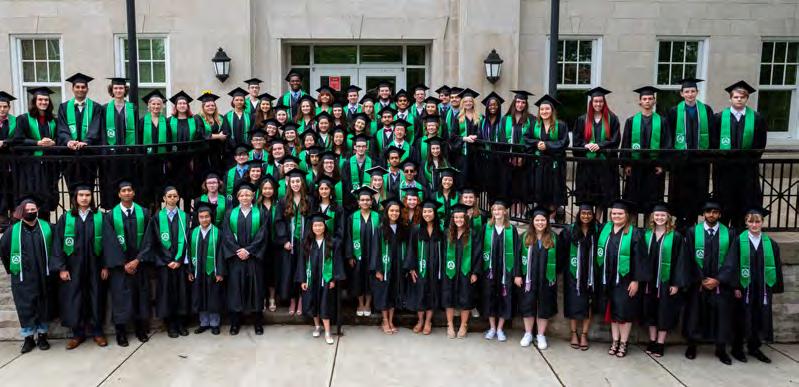




270.745.6565 academy@wku.edu @gattonacademy



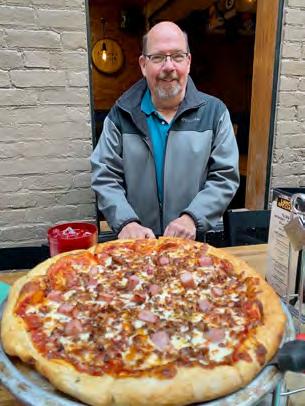
30 KENTUCKY MONTHLY MAY 2023
Follow along... @RiversideFoodTours Treat yourself to ‘speed dating for foodies’ with a restaurant tour
Covington's Cuisine Scene
BY DEBORAH KOHL KREMER
Covington boasts a variety of cuisines. In the mid-1800s, the city grew with an influx of German immigrants, so one might expect there to be a strong presence of food from das Mutterland available. There are some hearty options such as Wunderbar, which serves spundekäs, pork schnitzel and a selection of sausages. But Covington has so much more, including Irish, Italian and quintessentially American eats.
Riverside Food Tours offers threehour walking tours in Covington, where guests are introduced to the neighborhood, learn about local

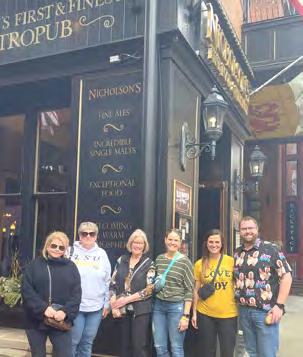
history, and enjoy a sampling of fare from five or six restaurants. Tour company owner Laura Noyes calls it “speed dating for foodies.”
“It is like a progressive dinner,” she said. “You get to visit several restaurants and sample a downsized portion of one of their favorites.”
The concept began in March 2016. Laura and her husband, Mike, took their first food tour in Newport, Rhode Island, and thought it could work in northern Kentucky.


“We loved the idea to combine sightseeing with the opportunity to try local food,” she said. “We started with Mainstrasse Village because it
is a quaint, charming little village full of local restaurants.”
The company has grown to offer 10 tours, seven days a week, that feature eateries in Covington and Cincinnati. More than 50 restaurants are on the tour, and eight guides share their expertise.
In addition to the samples of food, the tour shares the history of the areas visited. Guides suggest a variety of activities guests might want to pursue after the tour to keep the experience going.
“We have many guests take a tour and enjoy it so much they come back to take another, so we try to keep

kentuckymonthly.com 31
Keystone Bar & Grill
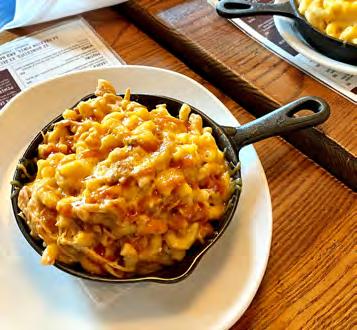
The Gruff
them as unique as possible,” Laura said. “It is nice to have a variety of guides because they are going to give you a tour from their point of view.”
• • •
David Wolff has been giving tours for three years but has lived in northern Kentucky all his life and enjoys sharing his knowledge with guests.
“I love the area and like showing it off to people on the tour,” he said. “I include little-known facts and stories about the area as we walk down the street.”
Aside from the Mainstrasse Village tour is one at Roebling Point, at the foot of the Roebling Suspension Bridge. Visitors go out onto the iconic bridge and learn about its history while they take in the Cincinnati skyline. On the walking portion of the tour, visitors stroll down Second Street, which is lined with historic

mansions, some dating back almost 200 years.
Offered on Thursday from 11 a.m.2 p.m., the Roebling Point Tour visits five restaurants. The first stop is for a serving of fish and chips at Molly Malone’s Irish Pub and Restaurant. The group moves on to Smoke Justis, a sports bar, for a barbecue brisket taco, then to The Gruff for a slice of wood-fired pizza. Next, Keystone Bar & Grill dishes out a serving of its famous macaroni and cheese. The tour wraps up with some rich bread pudding from Blinkers Tavern.

• •
•
The Mainstrasse neighborhood resembles a German village. It is home to historical buildings, unusual shops, locally owned eateries, the whimsical Goose Girl Fountain, and the memorable Carroll Chimes Bell Tower. The 100-foot clock tower, which is a working glockenspiel, has
32 KENTUCKY MONTHLY MAY 2023
21 mechanical figures that come out on the hour and depict the story of the Pied Piper of Hamelin.
The Saturday morning Mainstrasse Village Tour begins with a small-scale version of fried chicken and waffles from Cedar, then on to Mac’s Pizza Pub for a slice of pizza, pretzels with beer cheese at Cock & Bull Public House, a bourbon tasting at Wiseguy Lounge, and tacos at Taqueria El Valle Verde. The tour ends with a sweet treat at Piper’s Ice Cream Bar.
“People take these tours because they want to see what the local cuisine is and meet the local restaurant owners,” Laura said. “We usually meet at least one owner on every tour. We know they are busy, but they take time to pop out and greet our guests and answer questions.”
One of those owners is Chip
Adkins at Piper’s. While guests on the tour get to experience a dish of one of the shop’s 88 flavors of soft serve, Chip enjoys getting to know them. He picks the flavor but lets visitors choose from one of 40 toppings.

“I always ask where they are from, and it is interesting to see if they are local or have traveled to get here,” he said. “We have found over the years that we have quite a few regular customers who found out about us because of the tour.”
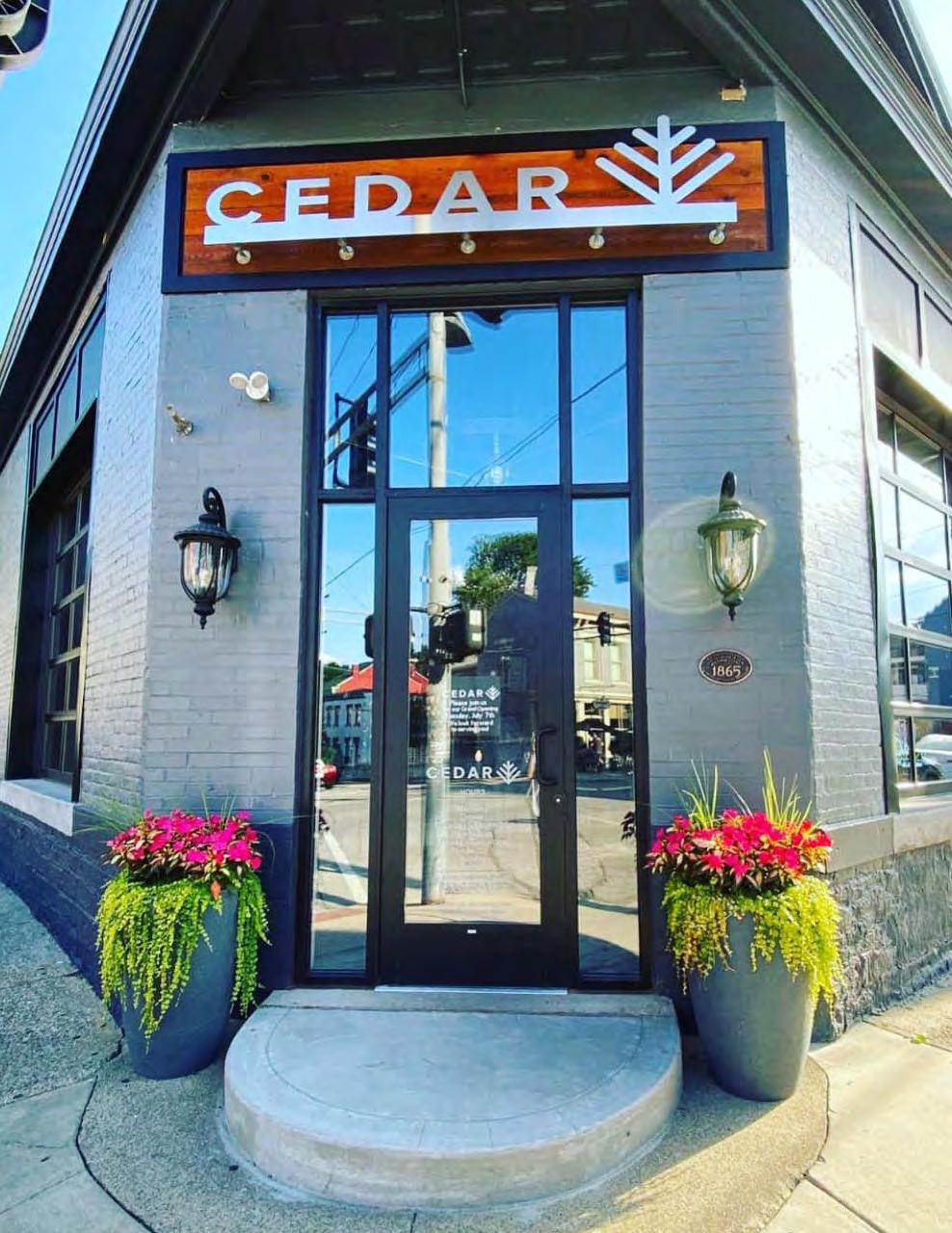
Laura said guests like the tours, not only because of the food, but also because of the information they receive. They learn about the area and get ideas for other things to do.
“We give folks a list of must-see attractions on both sides of the river,” she said. “We promise you won’t leave hungry, and you won’t be bored.” Q
riversidefoodtours.com

513.289.0035

kentuckymonthly.com 33
Piper’s Ice Cream Bar
Cedar Create memories of food and fun as you learn about the dishes you eat, the back stories of the restaurants, history, architecture and culture.
Take The B-Line

Situated on the banks of the Ohio River, northern Kentucky is the welcome mat for those arriving from the north into the bourbon state. Although most distilleries are in the central part of the state, the northern counties have their fair share of places to experience the production of bourbon or simply to imbibe.
In a nod to the waterway that once transported barrels of the famed liquor, the Ohio River was the Bourbon Line, otherwise known as The B-Line. Today, visitors can enjoy the area’s imprint on the bourbon culture by visiting five craft distilleries, six bourbon-centric restaurants, and seven bourbon bars with the help of The B-Line Guide, an 18-stop self-guided tour.
Bourbon makers include the Neeley Family Distillery in Sparta, Second Sight Spirits in Ludlow, The Old Pogue Distillery in Maysville, Boone County Distilling Co. in Independence and New Riff Distilling in Newport.


The restaurants on the tour include the Beehive Augusta Tavern, Tousey House Tavern in Burlington and Libby’s Southern Comfort in Covington. Although you can get a shot of bourbon at most any bar in Kentucky, the bars on The B-Line really show their dedication to the Commonwealth’s native spirit. The Old Kentucky Bourbon Bar in Covington, Prohibition Bourbon Bar in Newport and Three Spirits Tavern in Bellevue are just a few that are official stops on The B-Line.
A paper version of The B-Line passport is available at any of the stops, and the digital version can be download from the website. Check off two distilleries, two restaurants and two bars, and you’ll receive swag! Free merchandise includes your choice of B-Line branded T-shirts, hats and glasses.
Julie Kirkpatrick, president of the Northern Kentucky Convention and Visitors Bureau, which runs The B-Line, said that the bureau has distributed thousands of passports since its inception in 2018, and the five distilleries on The B-Line reported in 2022 that visitors were up 11 percent from 2021.
“We know people come to Kentucky for the Bourbon Trail, but we hope they come to northern Kentucky for their next sip,” Kirkpatrick said.

34 KENTUCKY MONTHLY MAY 2023
find your sipping point thebline.com 859.261.4677
The B-Line consists of five craft distilleries, seven bourbon bars, and six bourbon-centric restaurants. The 18 stops are located throughout Covington, Newport, Independence, Sparta, Augusta and Maysville,
All of B-Line’s bourbon bars have been named The Best Bourbon Bars in America by The Bourbon Review
Grant County Tourist & Convention Commission presents june 17 featuring



at Heart.
“What makes for excellence in heart care? It starts with one of the most amazing teams of heart surgeons, cardiologists and cardiac nurses that I’ve seen assembled under one roof. Combine all their skills with leading technology and the most advanced surgery suites and cardiac cath labs in the state of Kentucky, and you have heart care, here at the Heart and Vascular Institute of Eastern Kentucky, that is second to none.”












kentuckymonthly.com 35
Place the care of your heart in our hands. pikevillehospital.org | (606) 430-2201
Dermot P. Halpin, MD, FACS Cardiothoracic Surgeon, 27 years
Experts
SOUTHERN visitgrantky.com northern ky fairgrounds | 115 baton rouge road | williamstown ky
music, fun for the kids + more!
JD Shelburne
John Morgen
Michelle Robinson
Blake Tyler
To Make Whole
A NEW PAINT LICK RESTAURANT CELEBRATES


THE COMMUNITY’S AGRICULTURE AND HISTORY
BY KIM KOBERSMITH
There is an old joke about driving through a small town: “Don’t blink or you might miss it.” For Paint Lick in Garrard County, that adage almost applies. The compact downtown of a dozen buildings fills less than a city block. While there are operational businesses in town—a post office, auto repair shop and environmental consulting firm—the village vibe is a bit sleepy.
For visitors, that’s a good thing. It is a place to relax, breathe deeply and spend time not tied to a device (cell service is not guaranteed). An outing there feels a bit like playing hooky from regular life.

To enjoy a visit to Paint Lick: Pick a beautiful spring day; drive a leisurely backroad route to the town, about 40 minutes south of Lexington; grab a table on the patio of new restaurant Solidago; join in the convivial conversation across tables; feel the warm sun; and indulge in a delicious farm-to-table meal.
Solidago is in the center of the historical village. Originally the community’s general store, the neglected 1885 building had fallen into disrepair until Mark Gumbert bought the structure and renovated it. Last summer, Solidago quietly opened and has experienced organic growth ever since.
The name, Latin for the goldenrod
flower, was an intentional choice by Gumbert. Solidago gigantea derives its name from the verb solido, “to strengthen or heal,” and ago, “to make whole.” By serving local, carefully prepared food, Gumbert and the Solidago team hope to nurture the health of their diners and contribute to forming a stronger community.
Key to Solidago’s healthy food and upbuilding of the town is local agriculture. Hoot Owl Holler Farm grows many of the restaurant’s summer vegetables, Sylvatica Forest Farm produces mushrooms, and Sunwatch Homestead raises lamb and pork. Two farms are only a couple of
36 KENTUCKY MONTHLY MAY 2023
• •
•
miles away—Putnam Farm, which provides beef, and Lazy Eight Stock Farm, year-round provider of vegetables. Solidago is open to new local sources of products.
From the local bounty, Solidago serves an ever-evolving menu. It changes daily and is written on a chalkboard for easy adjustments. A couple of staples are a given—notably the burger and soup beans with cornbread. Other favorites, such as meal-sized salads and homemade gnocchi, are adapted to highlight seasonal components.
This writer had a flavorful dining experience inside Solidago on a chilly March day. One of the menu staples, homemade gnocchi, was

served with a collard greens and black walnut pesto. It was mildly bitter and complex, with hints of brightness from a lemon-zest and pine-nut topping.
A Brussels sprout Caesar salad was composed of shaved sprouts and a homemade dressing accented with apple slivers and crispy browned croutons. It ticked all of the veggie boxes, and the intensely flavored dressing made it a perfect winter dish.
The dessert menu is small, but I was grateful I ordered a chocolate chip cookie to share with my fellow diner. The hefty treat had a perfectly crisp outside and tender inside. The salt flakes sprinkled on top counterbalanced the just-right

sweetness of the cookie.
Overall, the menu reflected a sensitivity to the season and a unique blending of flavors. That creativity is thanks to Solidago’s chef, Jon Baugh
Chef Baugh grew up and attended culinary school in Lexington. He worked in several southern cities— notably Charleston, South Carolina, and Nashville, Tennessee—before returning to Kentucky in 2021. His training was classically French, and many of his formational restaurant experiences were in “high-caliber” establishments. But he eschews the fussiness of fine dining in his own restaurant.
kentuckymonthly.com 37
• • •
Diners at Solidago enjoy a comforting combination of china patterns; right, the welcoming entrance of the space that dates back to 1885.
A Paint Lick resident of more than 30 years, Paul Wells has dedicated his life to Great Pyrenees dogs, cycling and restoring vintage bicycles. A cycling enthusiast, he is committed to spreading the joy of the activity to the community.


Wells brings a newly restored vintage bicycle to display in Solidago each month. He painstakingly reworks them using era-appropriate parts— even down to the handlebar tape. Part history and part art, the bicycles displayed at the restaurant are beautiful treasures.

Solidago’s cuisine is inspired by sturdy country food from around the world that honors fresh ingredients. He has adopted a creative spontaneity for the menu and fosters a high-quality yet casual dining experience. The style is more inviting, less pretentious.
“I came back to Lexington, then met Mark and saw Solidago as a blank slate,” Baugh said about his involvement in the restaurant. “It felt right. Everything is right here, especially the farmers.”


During our conversation, Baugh was ensconced in the Solidago kitchen, braising lamb with red wine and baking focaccia for the next day. With a gleam in his eye, he recalled the freshest pork he ever served. It was butchered on a Wednesday, delivered to Solidago on Thursday,
and on the menu for lunch on Friday. “That is what it is all about,” he said.
Next, Baugh walked to the menu board to explain the day’s dishes. He stopped reading at the celery salad to wax poetic about the lowly vegetable. “It is one of the most underused ingredients out there,” he said. “So aromatic.”

Solidago is in a dry county, but a local vote in May could allow liquor sales in Paint Lick. Baugh dreams of brewing a trademark beer that incorporates goldenrod. When he does, it will be yet one more ingredient provided by the local land.
The experience of eating at Solidago cannot be separated from place. Diners are immersed into the center of small-town life. The interior
38 KENTUCKY MONTHLY MAY 2023
• • •
FOLLOW SOLIDAGO ON FACEBOOK TO SEE MORE!
solidagoky.com
Chef Jon Baugh, top, has developed a menu that reflects a sensitivity to the season and locally sourced ingredients to provide a creative blending of flavors.
of the space is a time capsule, with references to the past and present special nature of Paint Lick.
The wall directly to the right of the front door holds a rotating display of vintage bicycles, shared by a local resident in homage to the town’s placement on the TransAmerica Bicycle Trail. The components of the impressive bar— from the wooden columns to the skirting of beadboard to the surface— were salvaged from a local home slated for demolition. A bison head is prominently displayed, hearkening back to the days when the iconic mammals roamed freely and frequented the original paint lick to ingest necessary minerals.
Handcrafted dining tables populate the left side of the eatery. Historical photos line the walls: the inside of the old general store, one of the times the Paint Lick Creek flooded downtown, early citizens riding a buggy to town. The food arrives served on mismatched china dinnerware, some purchased at the nearby antique mall.
On the bar, next to the cash register, sits a pile of postcards. Everyone is welcome to take one. The front has a painting of downtown, with the words “Greetings from the Historic Village of Paint Lick.” The back shares some of the town’s unique history, leaving space to write a message. The folks at Solidago have already affixed postage. All visitors need to do is scrawl a note and address, walk across the street to the post office, and drop the card in the mail slot. It is one more way to share the special place of Paint Lick with a special friend.
At the time of this writing, Solidago was open Tuesdays through Saturdays, 11 a.m-3 p.m., but staff were poised to expand those times. For starters, Solidago launched a dinner event on the third Friday of the month. Check out the restaurant’s Facebook page for the most up-to-date info. Q
IF YOU GO Solidago
467 Main Street, Paint Lick 859.925.2000


• solidagoky.com

May 27 & 28

June 9 & 10
June 24
August 11

August 30
September 1 & 2
October 31
November 19
November 24 & 25
December 1 & 2; 8 & 9
Great American Kites
Lu-Ray Arts Festival

Rods & Ribs
150 Year Anniversary Celebration


Gospelfest
Everly Bros. Rock-N- Roll

Cruise-In/Car Show
Trick or Treat Christmas Parade
Lu-ville @ Lu-Ray Park
kentuckymonthly.com 39 CALL 800-348-0095 | WWW.VISITLONDONKY.COM DISCOVER your outdoor adventure in the heart of the Daniel Boone National Forest, EXPERIENCE the “Cycling Capital of Kentucky®” upon winding scenic highways, and IMMERSE yourself in Laurel Lake’s crystal blue waters.

40 KENTUCKY MONTHLY MAY 2023 Belly Up! For a list of locations, menu items and more, visit biscuitbelly.com. get more biscuits.
BY JACKIE HOLLENKAMP BENTLEY
A Louisville couple’s restaurant chain elevates the lowly biscuit to new heights
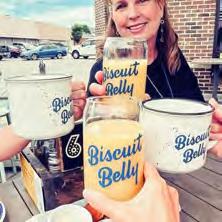


It’s around 11:30 a.m. on a Monday. It’s a little late for breakfast and not quite lunchtime at Biscuit Belly in NuLu, the East Market District adjacent to downtown Louisville, yet a line of customers waits to order. Those who have placed their orders have grabbed a table, claimed a booth, or bellied up to the counter to wait for their gourmet biscuit breakfast and maybe a mimosa or two.
The clientele is diverse: a young family with two toddlers in tow, a trio of runners meeting up after logging some miles, a couple on a blind date, and a veteran writer and her husband clandestinely conducting “research” for an upcoming magazine feature.
The orders also are diverse, given that there are more than a dozen variations of biscuit meals from which to choose, including a biscuit version of a Hot Brown complete with turkey, smoked gouda mornay, bacon and roasted tomatoes; the Belly
Buster made with a fried chicken breast, sausage, bacon, brisket, cheddar cheese, mushroom gravy and an egg all sandwiched into a biscuit the size of a large human’s hand; and The Boomer, a vegetarian option of a massive biscuit smothered in mushroom gravy.
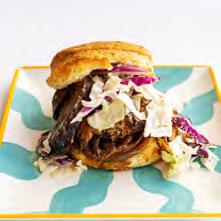
Inspired by the large homemade Southern biscuit sandwiches from their native Georgia, restaurateurs Lauren and Chad Coulter opened the NuLu location in May 2019.



Lauren said that her husband wanted to open a gourmet biscuit eatery but initially didn’t think their new home in Kentucky would support it.
“I thought, ‘He’s crazy. These people in Louisville are super posh. They’re never going to want these mega biscuits,’ and then, of course … I started seeing them pop up [around the country],” she said. “But we obviously saw the opportunity.”
Lauren said they wanted to put their own spin on the opportunity and tap into the highest growth areas
SOUTHERN
FARE WITH A TWIST...
in the United States food industry.
“We brought together the fastcasual space with fried chicken, which is continuing to boom, and brunch, and so bringing together those three areas of food … it intersects them all,” she said. “We have plenty of customers who come in for the speed of service … to get this massive, decadent biscuit sandwich quickly and sit down and enjoy it with their family and get out. We also have plenty of thirdshift workers coming in for a drink after work and sitting for a couple of hours with their mimosas and their biscuit.”
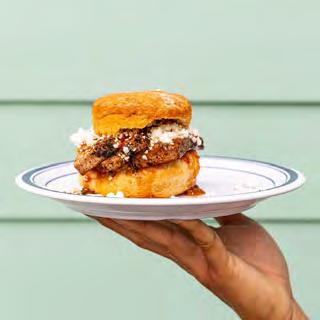
Mimosas aren’t the only adult beverages Biscuit Belly has on the menu. On offer are Bloody Marys, tequila sunrises, bourbon-spiked

coffee and a maple old fashioned. Lauren said the cocktails set them apart from the other gourmet biscuit restaurants.
“It’s a huge differentiator in this industry,” she said. “It just gives us another way to have a little something for everyone for breakfast.”
This unique approach to the biscuit brunch model appears to be working. The Coulters have opened eight locations in Kentucky and three other states (Alabama, Georgia and Indiana) with one in Chesapeake, Virginia, on the way. In Kentucky, Biscuit Belly has three locations in Louisville (NuLu, Middletown and St. Matthews) and one in Lexington.

THEY OFFER CATERING!
The Lexington restaurant was the Coulters’ first endeavor into a new business venture: They sold a Biscuit Belly franchise to Shoffner Family Foods, a family-owned franchise operation started more than 50 years ago by J. Roy Shoffner, one of the first Kentucky Fried Chicken franchisees. Today, second-generation Shoffners Jay and Kelly operate dozens of KFC and Long John Silver’s restaurants throughout Kentucky, Indiana and Tennessee.
It was Biscuit Belly that caught the eye of the third generation, sisters Madison Shoffner and Mallory Shoffner Quintero.
The two had frequented the Louisville Biscuit Belly locations “long before franchising became an option,” Madison said. “It’s our go-to
42 KENTUCKY MONTHLY MAY 2023
• • •
FOLLOW THEM @BISCUITBELLYBISCUITS

on the weekends, so it was a no-brainer for our family when we got the opportunity to sign on.”
Lauren said she and Chad made a list of what they wanted in a franchise partner, and the Shoffner sisters checked all the boxes.
“I think the night they officially signed on with us, I just cried, and it was such an ‘Oh my gosh, is this happening?’ moment,” she said. “They are people who know restaurants, who are just so engaged in their community, and who are fun people who we could actually sit around and hang out with. It’s so important.”
Since it was the first Biscuit Belly franchise to open, Lauren said they still had a lot of work to do to make sure their brand was well represented and their trust in Shoffner Family Foods was well placed.
“We had built pretty good systems for our stores, but making it so that things are replicable and can be easily repeated is so crucial,” Lauren said. “When you sign on to be the first franchise partner, you are setting yourself up for a few years of constant change, and they have been amazing partners in this. That’s been a huge blessing for us. We can’t even articulate how much it has helped us overall.”
For the Shoffner sisters, the downtown Lexington location was their first entry into the family franchise enterprise, and it turned out to be a great market in which to get their feet wet.
“We have been so well received by the Lexington market,” Madison said. “We started off on Main Street, right as you’re going into downtown. We felt that was a great central location. We were big fans, and we knew it would be successful.”
So successful that the sisters are planning to “spread the love” with two more Lexington locations—one in the Leestown Road area slated to open by the end of the summer and another in the Ethington Shops on Harrodsburg Road targeted for the beginning of 2024.

kentuckymonthly.com 43
WINE & GOAT

PAIRING

To order: kentuckymonthly.com


1-888-329-0053
As for the expanding Biscuit Belly enterprise, more than 20 franchises are in development. An initial buy-in for a Biscuit Belly franchise is between $697,000 and $1.1 million.
Madison said it is well worth the investment. The Coulters “really, really believe in their product and their business,” she said. “They made
it easy for us to get excited about it, and that’s truly what it has been from day one.
“It’s something that we’ve fully bought into and are totally excited about and talking to everyone about. We would never want to push something that we didn’t totally back one hundred percent, and Biscuit Belly was easy for us to get behind from the very beginning.”
BISCUIT BELLY HAS FOUR KENTUCKY LOCATIONS


MIDDLETOWN,

44 KENTUCKY MONTHLY MAY 2023 • • •
Q
NULU, ST. MATTHEWS, LEXINGTON For location or catering information, menu items and more, visit biscuitbelly.com.
CHEESE
at Baker- Bird Winery & Distillery
Horticulture meets humor in gardening columnist Walt Reichert’s collection.
o o o o o
Get ready for gardening season with this down-home collection of practical advice and personal anecdotes from Kentucky Monthly’s gardening columnist, Walt Reichert. Organized by the seasons, each chapter offers color photography and straightforward tips for everything from combating critters to pairing plants. The Bluegrass State’s green thumbs have proliferated, thanks to Walt’s encouraging and down-to-earth morsels of gardening wisdom.
Humor
WW_fullpg.indd 51 1/9/15 10:40 AM
Horticulture Meets
shopkentuckymonthly.com 888-329-0053









kentuckymonthly.com 45 Compare all options with just one call... AUSTIN TYLER LICENSED INSURANCE REPRESENTATIVE 859.618.6443 TURNING 65? NEED MEDICARE ENROLLMENT HELP? MEDICARE ADVANTAGE QUESTIONS? Questions? We have answers! WE SPECIALIZE IN Medicare Supplement Plans Part D Prescription Plans Medicare Advantage PPO & HMO Plans Dental & Vision Options Offering Life Insurance and Medicare & Crafts Folk Arts CAPITAL OF KENTUCKY Berea Experience T H E visitberea.com we know you won't leave empty handed. BEREA FESTIVALCRAFT -July 7-9 L&N DAY -June 17 C M Y CM MY CY CMY K Berea_KyMonthly_April_3.4x4.8_HR.pdf 1 3/1/23 10:15 AM
Genealogical & Historical Research Library

Explore our treasure trove of regional records: manuscripts, books, historical records, & etc.

Discover your family origins: genealogical files, business legders, marriage records, & more
Research famous and everyday historic figures: Daniel Boone papers, Sanborn Maps, Simon Kenton collection

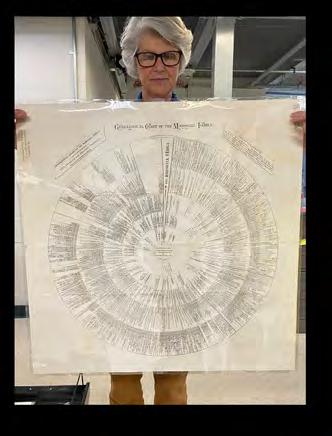
Understand historical events and locations: KY maps, Church histories/records, emancipation deeds, & etc.

46 KENTUCKY MONTHLY MAY 2023 KENTUCKY
215 Sutton Street Maysville, Kentucky 41056 606-564-5865 www.kygmc.org Hours: Tuesday-Saturday 10am-4pm
of sutton & west 2nd Streets kygmc campus
GATEWAY MUSEUM CENTER
The Old Pogue Experience located in the limestone building on the corner

K E NTUCKY E XPLORER A section for Kentuckians
… inside Kentucky Monthly. Featuring Things Old & New About Kentucky Volume 38, Number 4 – May 2023 All About Kentucky Your Letters -- page 48 The Doyle Stampede of 1848 -- page 52 Kentuckians Who Sought the White House -- page 54 “I Remember” By Our Readers and More!
The 1901 Kentucky Derby was the 27th running of the Kentucky Derby. The race took place on April 29, 1901.
everywhere
This undated photo is of Clark Hardware Co., located at the corner of 367 West Short and North Broadway in Lexington. The buiding, which is on the National Register of Historic Places, was constructed just after the Civil War and was home to grocery stores, dry goods shops and furniture stores. Clark Hardware occupied the space from 1923-67. Photo courtesy of University of Kentucky, Special Collection and Research Center.
Kentucky Explorer
Kentuckians
Another Victim of ’37 Flood
Letters to the Kentucky Explorer
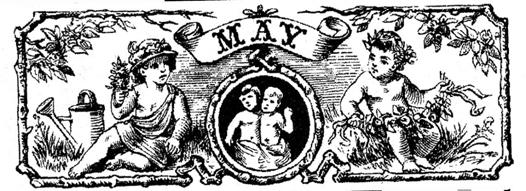
Store Damaged by the 1937 Flood
I always enjoy the Kentucky Explorer section of Kentucky Monthly magazine. When I saw the photo of the old store in the February 2023 issue (page 50), I thought of this photo, which was taken in March 1928.

Reunited with Kentucky Explorer
The March issue of Kentucky Monthly was the first that I have ever seen. I was impressed by both the cover and the contents.
I was delighted to find a section dedicated to Kentucky Explorer. I subscribed for many years and was a frequent contributor. I am looking forward to receiving Kentucky Monthly for years to come.
I am a native Kentuckian, born in Menifee County. Although we migrated to Ohio in 1956, I spent summers on my grandfather’s farm. I consider myself a Kentucky native. Now retired, I spend my time writing. I’ll publish my memoir, The Long Ride Home, sometime later this year.
Roger D. Keith, Clearwater, Florida
96 Years Young
Dean Stanley Locke, on the left, was my uncle by marriage. He was the son of a Confederate veteran and was born near New Concord (Calloway County) in 1881. He bought logs for a cooperage firm in the early 1900s and later owned this store on East Jefferson Street in Louisville. The store was flooded in 1937, and I don’t know if it ever reopened. When the flood waters receded, the only thing left on the shelves in the whole store was one bottle of vanilla flavoring. The man on the right is Dean’s helper, Jesse, but I do not know his last name. Some of the brands of the products are the same as those found today, but others are not so familiar.
James Patterson “Pat” Wilson, New Concord
Have you ever wondered what it would be like to live in an “Old Folks” home? From my perspective, it is not so bad. I don’t have to cook; I don’t have to clean; I don’t have to do laundry. Every week, friends come to play Scrabble, and different friends come to play bridge. I also play bridge with some of the residents here. It is good to keep the old mind working. I love to read, and I have more time to read now than ever before. Last year, I read 48 books, and I’m a slow reader. My goal this year is to read 52 books—one for each week. I also enjoy television, especially the programs on public television. I am never bored.
As the Good Book says, “To everything there is a season, and a time for every purpose under Heaven …” This is my season for growing old among my peers, and I am content.
Thought for the day: “Most folks are about as happy as they make up their minds to be.” — Abraham Lincoln
Betty Isaac Smith, Frankfort
48 THE KENTUCKY EXPLORER The first Kentucky Derby to be broadcast live on the radio was aired on WHAS on May 16, 1925.
FOUNDED 1986, VOLUME 38, NO. 4
a magazine published for
everywhere Charles Hayes Jr. • Founder Stephen M. Vest • Publisher Deborah Kohl Kremer • Editor Rebecca Redding • Typographist
Kentucky Explorer appears inside each issue of Kentucky Monthly magazine. Subscriptions can be purchased online at shopkentuckymonthly.com or by calling 1.888.329.0053.
In memory of Donna Jean Hayes, 1948-2019
may be edited for clarification and brevity. Please send letters to Editor Deborah Kohl Kremer at deb@kentuckymonthly.com or mail to Deb Kremer, Kentucky Monthly, PO Box 559, Frankfort, KY 40602. One-Year Subscription to Kentucky Monthly: $20
Letters
Family Ties Brought President Jimmy Carter to Centre College Graduation
By Jerry Boggs, editorial director, Centre College
Former President Jimmy Carter addressed Centre College’s graduating class during commencement exercises in 1987. One alumni remembers how that visit came to be.
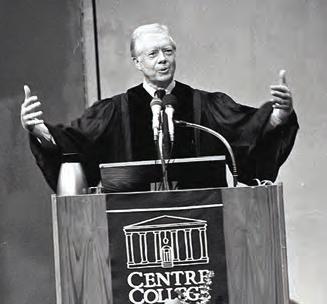

The nervousness Bart Sights felt as he took his place behind the podium on the Norton Center for the Arts stage wasn’t because he was about to announce the 39th president of the United States as the speaker at his commencement ceremony. He was nervous because all his classmates were watching.
For Sights, an economics major from Henderson, Carter was practically family. By the time Centre College’s 1987 commencement came around, he had known Carter for a decade and had visited the president in the White House.
Sights was the reason the former president spoke at Centre College that day.
Their connection began with a different speaker backing out of an engagement back in 1974. Sights’ father, Dale, was president of the Henderson Chamber of Commerce and suddenly in need of a new guest speaker after the scheduled speaker, Kentucky comedian Grady Nutt, backed out at the last minute.
“My dad was complaining on a Sunday night that he had to find somebody,” Sights recounted during a phone interview from San Francisco. “My mom was an avid Sunday New York Times reader back then, and she said, ‘You should call this guy I’m reading an article about. He’s governor of Georgia, and he’s thinking about running for president.’
“And my dad literally picked up the phone and called, and Carter answered.”
Carter, who had not yet officially announced his candidacy for the president of the United States, agreed to speak at the dinner on one condition.
“He said, ‘Sure, I’ll come talk to your chamber of commerce … if you don’t mind me staying at your house so I don’t have to get a hotel room,’ ” Sights recalled.
And that’s how a 10-year-old Bart Sights slept on the floor while the future president slept in his bed.
That interaction led Carter to hire Dale to lead his campaign efforts in Kentucky and work closely with the president during his time in the White House.
Seeking reelection in 1980, Carter returned to the Sights home. By that time, Bart was a teenager and soon would
be looking for a college where he could play football—a decision that ultimately came down to Vanderbilt University and Centre College.
“He was asking me what I was going to do and what I was interested in,” Sights said. “I think at that time he said, ‘If I’m still alive, still around when you graduate from college, I’ll speak at your commencement.
“And it’s just who he is. He keeps his word.”
Seven years later, with commencement approaching, Dale Sights called Carter to tell him Bart was getting ready to graduate from Centre. “He said, ‘I’ll be there.’ ”
And that’s how a nerve-wracked economics major came to be at center stage on the day of his college graduation introducing the former president of the United States.
“I had no experience in public speaking, and I was so nervous,” Sights said. “I remember I was absolutely shaking. And I was more nervous about my classmates than President Carter.”
A few years ago, many in the Sights family made a trip to the Jimmy Carter Presidential Library and Museum in Atlanta so the younger generations could meet the former president and first lady. Bart was unable to attend, but his kids were among those in attendance.
“My parents took all of the grandchildren—there were probably 17 of them—and visited President Carter and Rosalynn and spent the afternoon with them,” Sights said. “That was incredible.”
Sights, who lives in San Francisco and serves as vice president for technical innovation at Levi Strauss, said the Carters’ legacy is as much a tribute to who they are as to their contributions to society.
“He was always such a sweet man. And you really can’t mention him without Rosalynn. She’s an incredible lady,” he said. “He did a lot of great things as president, and then he gave the rest of his life to making the world better.
“That’s the people they are.”
Sights said the news that Carter was entering hospice care was tough to hear.
“We’ve known it was coming, but it’s really hard. It’s really emotional for me,” he said. “He’s a hero. He was a hero for me from the time I was 10 years old. I think he’s been a hero for a lot of people.”
May 2023 49
Comedian and actor Foster Brooks was born in Louisville on May 11, 1912.
Article Courtesy of Centre College, centre.edu.
From left, then-Centre President Richard L. Morrill, Carter and James H. “Jim” Evans
Remember”
Mr. Reed’s Cow Ate Pug’s Spelling Book
From Odell Walker’s book, In Lyon County, Saturday Was Town Day
When I entered first grade at rural Hebron School in the early 1930s, I met a fellow first grader, Eugene “Pug” Bailey. Pug and I remained good friends throughout the school years and until his untimely death a few years ago. We liked to wrestle, and we spent much recess time wrestling. Pug was a bit stronger than I was, and he won most matches. I was a bit faster than Pug, and I won most of the foot races. When we chose up to play baseball, we normally had to play the position where needed, but if we had our preference, I liked to play outfield, and Pug liked to catch.
In those days, everyone in the rural areas walked to the one-room school. We always took the shortest route, whether it was the roadway or a path across the fields. Pug’s family lived on the road, and he normally walked the roadway to school. When school was out, my brothers and I walked along the road with everyone else for a short distance and then turned westward and followed a path through the fields to our house. On the path to school, we passed by a big clear pond on the farm of Mr. P.L. Reed. On many afternoons, my brothers and I would stop and take a swim before we got home. Keep in mind that those rural schools started about the second week of July, and on a pretty afternoon, everything was just right for swimming. One afternoon, I asked Pug if he would like to follow the path with us and stop at the pond to take a swim. Pug accepted the invitation without hesitation. We walked through the field and came to a large scaly-bark hickory tree in the fencerow. We could see the lake, but we would both need to return to this point to continue our separate ways home.
Pug was carrying his lunch pail, which was a 4-pound lard bucket, and his spelling book. We didn’t want to be burdened down with any excess luggage, and we allowed as to how it would be all right to leave the lunch bucket
The Boy Who Painted His Dog
By Doug Slone, New Port Richey, Florida
I was born in 1947 at Raven in Knott County on my grandfather’s farm. He had a general store and was the postmaster.
My parents and I lived a quarter of a mile up the road in a house my grandfather had built for my mother. In the back of the house was a 10- by 12-foot storage shed.
and spelling book laying on the ground in the shade of the hickory tree until we returned from the swim.
We pulled our clothes off and lay them on the ground and had a good swim for 20-30 minutes. While we were swimming, Mr. Reed’s cows came to the shade of the hickory tree and found Pug’s spelling book. Somehow, a cow managed to separate the pages from the backs of the book and ate the paper, leaving the hardback cover. When we arrived, it was easy to see that the cows had been up to mischief. The lunch bucket had been knocked over and rolled several feet, and there was nothing left of the spelling book except the backs, which had not been chewed up. Pug’s name was still very clear in the space showing that the book had been issued to him.
We were both frightened and pretty well knew we were in for trouble the next day at school. This was just a few years after the state had started issuing free textbooks. Teachers had put the fear of the Lord into all students that, if anything happened to the books, our parents would have to pay for them. Pug just knew he would have to come up with the money to pay for the spelling book, and, furthermore, we didn’t know how the teacher would react to Pug taking a route home other than his usual way.
The teacher was Mr. Everett Ralston, and to his back, we all called him “Cat.” He was known to be a stern disciplinarian. Pug and I conditioned ourselves to be prepared for the worst but hoped for the best. The next morning, Pug took the backs of his spelling book to Mr. Ralston and told him what happened. The teacher must have been in a good mood that morning because he chuckled and said something to the effect that he supposed the cow was searching for an education. He also told Pug that the back of the book still had his name on it, and he would turn it in to the superintendent’s office at the close of the school year, but Pug wouldn’t have to pay for it. He cautioned us that we might do well if we stuck to our established routes to and from school. Pug and I were not always so lucky, but we came out of that one smelling like a rose, or pond water.
In the summer of ’51, I turned 4, and my dad was painting our house. Having a big imagination, I wondered what a white-spotted dog would look like with a different color. Seeing my dad put all the painting supplies in the shed, I grabbed the dog and went in, closing the door behind me. Mixing turpentine and paint, I grabbed a brush and went at it on my dog.
Everything seemed to be OK until the mixture hit the dog’s bare skin. The dog started yelping and doing laps.
4 THE KENTUCKY EXPLORER 50 THE KENTUCKY EXPLORER
your memory in today! The town of Lexington was established on May 6, 1782, by an act of the Virginia General Assembly. Send memories to Deborah Kohl Kremer at deb@kentuckymonthly.com or mail to Kentucky Monthly, Attn: Deb Kremer, P.O. Box 559, Frankfort, KY 40602.
“I
By Our Readers Send
, My dad told me that he was in the house with my mother when they heard a tremendous noise. He ran to the shed, threw open the door, and the dog shot between his legs and ran out of sight. Dad said he found me standing in the middle holding a brush and laughing hysterically. He knew exactly what happened. The dog could hardly breathe from my mixture, so the neighbors tried to catch him to put him down. Because of me, he was gun shy of people, and to this day, no one knows what happened to him.
When I was 6, we moved to Ohio so my dad could work at the Ford plant. Every summer, I went back to Kentucky and the farm. No one ever said anything to me. They just smiled, but I knew what they were thinking!
In my early 20s, I went back for a visit. My grandfather had passed, and my grandmother and aunt ran the store and post office.
I was in the store when a stranger came in, bought groceries, and picked up his mail. He stopped and looked at me and asked, “Are you Jonas Slone’s grandson?”
“Yes, sir,” I replied.
Pausing, he asked, “Are you that boy who painted his dog?”
Embarrassed, I said, “Yep, that was me!”
He gave a big laugh, slapped his leg, and left.
I still miss those summers at the farm, playing ball, swimming, fishing and climbing mountains. I especially miss the barefoot kids who knew how to enjoy their summers doing simple and fun things.
At 75, I believe all those who remembered me are gone, and hopefully the “legend” of that 4-year-old has died.
As I got older, I realized what I had done to that poor dog. Needless to say, I regretted it.
Wanna Know Where I Come From?
Stepping into an old barn instantly takes me back: The musty odor of moist hay and stalks of tobacco hanging from the rafters, Slowly turning from green to brown in the humid air.
I’m always reminded of visits to my grandparents’ farm, just outside of town.
I remember Old Tom, put up after a day of plowing, Crunching on an ear of dried corn, nuzzling up to the hide-smoothed rail of his stall,
Perhaps expecting a real treat: a sweet, bruised and worm-pitted apple, Plucked, with his enormous, soppy lips from my quickly retreating hand. Outside the back wall, the incessant clucking of chickens
And the snorting of pigs, wallowing in the mud.
Then there was Mammaw, calling Pappaw out of the field for supper, And his usual reply, “I’ll be there directly.”
(It was several years until I realized that The word “directly” meant something other than, “when I get done with what I’m doing.”)
Warm summer evenings on the worn, wooden porch
Watching Mammaw snapping a mess of beans
Or handily weighing and bundling bunches of asparagus in white twine.
Hooping It Up After All These Years
By Debbie Grise, Russellville
I remember my favorite toys of the 1960s and ’70s. My Barbie dolls were my favorite for inside play and my Hula Hoop was my favorite outside toy. I was lucky enough to own an actual Wham-O Hula Hoop and not a knockoff. My hoop entertained me for hours during my girlhood days.
In the ’80s, my husband bought me a
Next morning Pappaw, loading them along with baskets and boxes
Of green beans, yellow squash and red tomatoes Into his black pickup for his daily route in town.
The buzzing of monstrous flying beetles
Crashing into the ceiling as they Flitted about the single bulb dimly illuminating the porch; Great, artfully colored moths larger than my hand, Whose exotic names I would learn only later: Sphinx, Cecropia, Promethea, Luna and Io.
Sunday afternoons after church, sitting down to a dinner
Of fried chicken, enormous bowls of mashed potatoes, gravy, Butter beans, and corn on the cob, dripping with butter. And what I looked forward to the most, steaming hot apple pie. Afterward, Pappaw retiring to his hammock suspended betwixt two big maples, Taking his one day of rest.
In a way, I reckon you could say I came from that little vegetable farm, My mother’s childhood home. So, wanna know where I come from? Step into that old barn.
reproduction Wham-O hoop, and I “hooped it up” every chance I could. By the ’90s, I was performing for hours at a time.
Now at 64, I am recognized as The Hula Girl. Recently at the 66th Anniversary Car Show at Red Boiling Springs, Tennessee, I performed for three hours straight.
I am thankful to still be able and “hooping it up” after all these years. As long as I am blessed to be able to perform, that is my plan. Hula hooping is a dying art. Many remember when they hula hooped, but few still can.

May 2023 51
The first train on the Lexington & Big Sandy Railroad traveled from Lexington to Winchester on May 15, 1872.
This poem was written by George Robertson of Frankfort, who reminisced about visits to the farm of his grandparents, George and Effie Mae Siebe, just outside of Owensboro, as a boy in the 1950s.
The Slave Rebellion Known as
The Doyle Stampede of 1848
 By Mikael Levin, Bellport, New York mikaellevin.com
By Mikael Levin, Bellport, New York mikaellevin.com
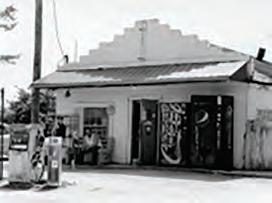
Aslave rebellion known as the Doyle Stampede took place in northern Kentucky in 1848. I have been photographing the area for my project Critical Places; Sites of American Slave Rebellion Originally, what I found particularly interesting about this rebellion was that it presented an early example of racial disparity in criminal prosecution—of how a white man got a jail sentence for organizing a failed escape of the enslaved, while the escaping enslaved were sentenced to hang. But it turns out there is another story that also needs to be told. It is a story of two men whose lives intersected in this rebellion—E. Patrick Doyle, the white man who organized it, and Harry Slaughter, one of the enslaved Black men who participated.
It started out an escape, not a rebellion. Doyle led a group of around 40 enslaved men north from Lexington, planning to get them across the Ohio River to freedom. However, the escape (or “stampede,” as these were referred to at the time) was quickly detected, and a posse was sent after them. After a three-day pursuit through Harrison, Robertson, Bourbon and Bracken counties, during which the escapees tried to fight off their pursuers, they all were captured. Early reports stated (erroneously, it seems) that one of the members of the posse was shot and killed. As a result, the escape was deemed a rebellion, and the captives came close to being lynched.


We might regard Doyle as a heroic abolitionist for having tried to spirit 40 men to
freedom, but actually it is not clear just what sort of person he was. He seems to have been something of a drifter, having studied in Danville and Bardstown, and then there were reports of him living variously in Cincinnati, Louisville, Lexington and Frankfort. Perhaps it was character assassination, but during the ensuing trial, unsavory stories came out about him—that he’d once been accused of stealing money and another time accused of being a horse thief. He wa once arrested for holding several freemen, trying to sell them into slavery. Then, too, it seems that he’d charged each of the enslaved $10 to join the escape. (Does that make him a human smuggler?) Doyle was sentenced to 20 years in prison.
Slaughter was sentenced to hang. However, he did not meet that fate. In fact, he lived to tell his story.
What I have learned about Slaughter is mostly thanks to a local researcher, Caroline Miller, whose book Strange Experiences; Escaping Plantation Life is filled with information about the events of 1848. Most surprising to me was to find there a reprint of an interview with Slaughter, published in the Lexington Morning Herald in 1897.
In my readings about rebellions, it is often noted that the little we know of them is almost always from white people. Yet there was Slaughter telling his own story!
Interviewed when he was 81, Slaughter told of his life as a slave and of how, during the 1848 escape, he—a big man— fought off his captures. He told of how his mistress got his sentence commuted, and how he later was able to buy his freedom, marry his sweetheart, and make a good living as a house painter.
“I raised five children,” he said. “Yes, I guess I was one of the best men physically that God Almighty ever made. I
“Have ambition to work, willingness to work, and integrity in what you do.” Colonel Harland Sanders
6 THE KENTUCKY EXPLORER 52 THE KENTUCKY EXPLORER
Top, the probable site of Harry Slaughter’s capture at Santa Fe in Bracken County; middle, Ruddles Mill Road in Bourbon County; above, Brierly Ridge Road in Robertson County; inset, Powersville Mercantile in Bracken County.
don’t believe there was a man living that could have bested me in a fist and skull fight when I was 35 years old. All the other boys who were with me during that memorable struggle for liberty are dead. I don’t suppose I will last much longer, but thank God I have lived for 46 years a free man.”
Although the article was written by a white journalist, Slaughter’s voice comes through.
Doyle, sentenced to 20 years hard labor at the Kentucky

State Penitentiary in Frankfort, was put to work in the “factory of death” hemp processing facility. That is the last we know of him.
Slaughter lived to the age of 89, 54 of those years as a free man. He lived at 182 East Short Street in Lexington. He died on June 14, 1906.
One thing I wonder: Harry Slaughter said that he raised five children. Do his descendants know of this remarkable ancestor?
Covered Bridge from Frankfort’s Past
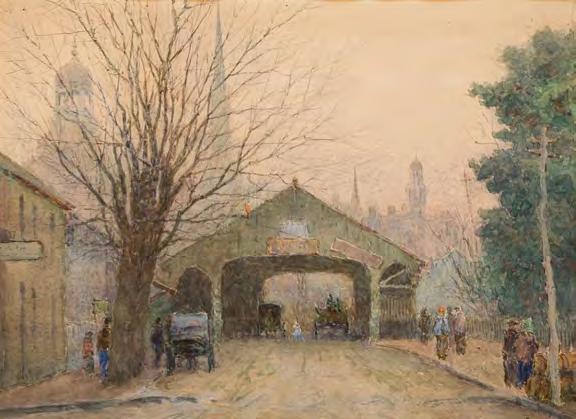
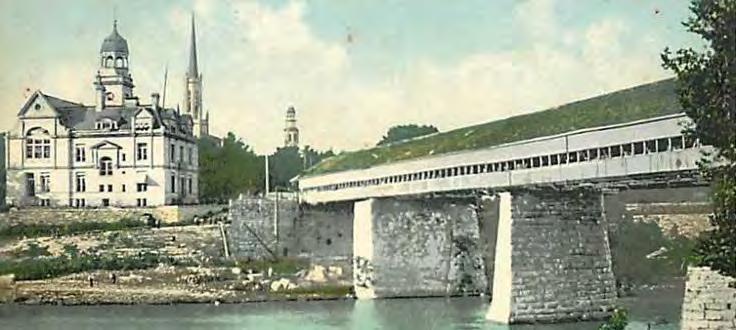
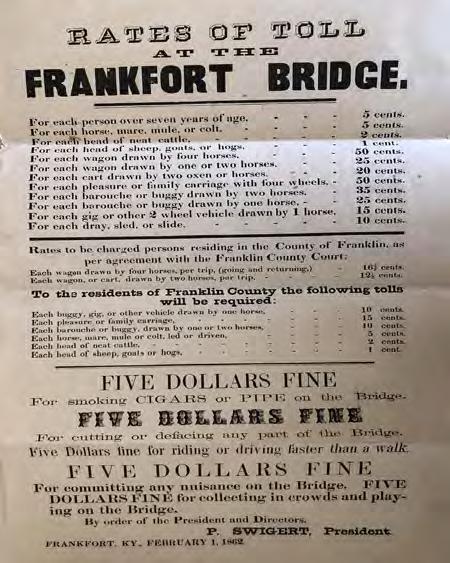
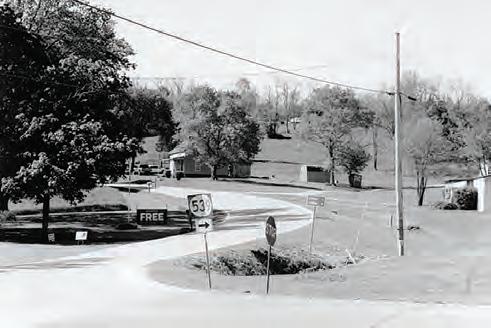
Ten constitutional conventions were held in the Constitution Square Courthouse in Danville between 1784-1792. May 2023 53
Mikael Levin photographs of the route probably taken by the escapees.
Left, Milford in Bracken County; above, Cynthiana in Harrison County
Photo courtesy of J.G. Moore, Frankfort
Upper left, “Old Covered Bridge at Frankfort, Kentucky” painting by Paul Sawyier; left, this wooden covered bridge spanning the Kentucky River was known as the Frankfort Bridge. It was replaced by the Singing Bridge in 1893, which still stands today; above, note the toll rates in 1862.
Kentuckians Who Sought the White House
By John W. McCauley, Lexington
Our great Commonwealth was once a major player in presidential elections, dating back to 1824, when the Honorable Henry Clay, speaker of the United States House of Representatives, went against Sen. Andrew Jackson from Tennessee, Secretary of State John Quincy Adams, and Secretary of the Treasury William H. Crawford. Jackson’s entry into the race was detrimental to Clay and helped erode his western base. It was Jackson who led in both the popular and electoral vote but failed to garner the needed majority. Short of a clear majority, the election, under the 12th Amendment, went to the U.S. House of Representatives to be decided. On Feb. 9, 1825, Secretary of State Adams was elected as the sixth president of the United States. Clay, much to his disappointment, finished fourth, but President Adams appointed him secretary of state. Clay—who became known as an orator, statesman and The Great Compromiser—was born on April 12, 1777, in Hanover County, Virginia. He migrated to Kentucky in 1791 with his family. Clay was educated at the College of William and Mary and admitted into the Virginia Bar. He married Lucretia Hart on April 11, 1799, at her family home in Lexington.
When the 1832 presidential election came around, Clay had served three terms as speaker of the House and was a sitting U.S. senator. He became the nominee for the National Republican Party that he had founded in 1824. He went on to lose in the general election to incumbent President Jackson, who had founded the Democratic Party. Clay ran on a platform of his “American System,” which called for nationally financed internal
improvements and a protective tariff.
In 1840, Clay sought the nomination of the Whig party, which he and other anti-Jacksonians had formed in 1833 after the National Republican Party dissolved. Clay was passed over for the nomination in favor of William Henry Harrison, a Virginia native, former general and U.S. senator from Ohio, who defeated Democratic-Republican incumbent President Martin Van Buren. Kentuckian
Richard M. Johnson was vice president under Van Buren. Born on Oct. 17, 1780, in Beargrass, Virginia (present-day Louisville), Johnson lived in Scott County when he was elected the ninth vice president of the U.S.
The 1844 presidential election saw the return of Clay as the Whig nominee. He ran against Democrat James K. Polk, a former speaker of the U.S. House of Representatives and governor of Tennessee. Clay lost in a close election. The issues of slavery and the annexation of Texas were controversial and divided both parties. Further, Polk’s support of Manifest Destiny was beneficial to his campaign. A staunch Clay campaigner was Kentucky-born Abraham Lincoln, who had served several terms in the Illinois House of Representatives and described Clay as “my beau ideal of a statesman.” A few years later, Congressman-elect Lincoln would have the opportunity to visit with Clay at his Ashland estate during a family trip to Lexington.
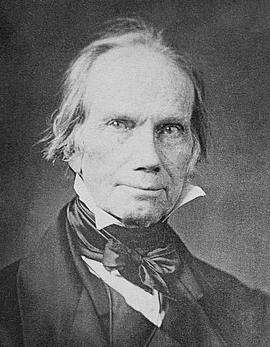
The 1848 Whig primary pitted two Kentuckians against one another—Lexington’s Clay and Gen. Zachary Taylor, who lived in Louisiana but hailed from Jefferson County. Taylor was born in Orange County, Virginia, but his family had joined the westward migration and settled near the Ohio River in Louisville when Taylor was just a youngster. This would be the first of two occasions that Kentuckians would run against one another for president. Although Congressman Lincoln, a Whig from Illinois’ 7th District, highly favored Clay, he felt that “Old Rough and Ready” had a better chance to unseat incumbent President Polk. Taylor went on to win the Whig nomination and defeat Polk in the general election. Taylor never had voted nor sought political office prior to this election. President Taylor served just 16 months before dying of cholera. He is buried at the Taylor National Cemetery in Louisville. Taylor’s daughter Sarah married Kentucky-born Jefferson Davis

That would be the last time that Clay would seek the office of president. After five unsuccessful attempts, he died of tuberculosis on June 29, 1852, in Washington, D.C. Thousands of citizens gathered in Lexington to pay tribute to Clay. The Great Compromiser was laid to rest in the Lexington Cemetery.
In the years following Clay’s death, our nation would continue to see a growing divide over slavery. Lincoln all

54 KENTUCKY MONTHLY NOVEMBER 2020 54 THE KENTUCKY EXPLORER
Abraham Lincoln
Henry Clay Zachary Taylor
Since 1933, Pine Mountain State Resort Park has hosted the Kentucky Mountain Laurel Festival.
but saw himself out of politics after his loss to Sen. Stephen A. Douglas in the 1858 Illinois U.S. Senate election. Lincoln ran as a Republican after the Whig party declined and dissolved.
Much to Lincoln’s surprise, his name was brought forth as a candidate for president at the 1860 Republican National Convention in Chicago. The perceived frontrunner was Sen. William H. Seward of New York. Also in the race were Ohio Gov. Salmon P. Chase and two other candidates. Seward led the first ballot but lacked the needed majority, with Lincoln finishing a strong second. During the second ballot and the jockeying of delegates, Lincoln tied Seward. By the third ballot, it was Lincoln, who was born poor on Feb. 12, 1809, in a one-room log cabin on Sinking Spring Farm in present-day LaRue County, who became his party’s nominee. Kentuckian Cassius Marcellus Clay, an abolitionist from Madison County, lost on the second ballot to Hannibal Hamlin for the vice presidential nomination but later would be appointed by President Lincoln as the U.S. ambassador to Russia.
The 1860 general election once again would pit former Congressman Lincoln against Douglas, the Democratic nominee, as well as Vice President John C. Breckinridge from Lexington, a pro-slavery Southern Democrat, and U.S. Sen. John Bell of Tennessee, the nominee of the Constitutional Union Party.

Breckinridge was a childhood playmate and next-door neighbor of Mary Todd Lincoln. When the vote was counted, it was Lincoln who won in both the popular and the electoral vote. Breckinridge was second in the electoral vote but third in the popular vote. Douglas was second in the popular vote but last in the electoral vote. Bell finished third in the electoral vote but last in the popular vote. Bell carried Kentucky over Lincoln and Breckinridge. Lincoln ran last in his home state with less than 1 percent of the vote. The Kentucky results: Bell, 66,058; Breckinridge, 53,143; Douglas, 25,651; and Lincoln, 1,364.
In 1864, President Lincoln had all but conceded defeat in the upcoming election and was preparing for the peaceful transfer of power. Plagued by the civil war, the death of his son Willie, and the depression of the first lady, his plate was full. Lincoln selected Tennessee Military Gov. Andrew Johnson, a Democrat, as his running mate. They ran under the banner of the National Union Party. Lincoln earned 55 percent of the vote to defeat Gen. George B. McClellan, the Democratic nominee. While Lincoln had a much better showing in Kentucky with 27,787 votes, he lost the state to McClellan, who received 64,301 votes. Kentucky was the only state McClellan carried.
President Lincoln gave his second inaugural address on March 4, 1865, at the U.S. Capitol. He was shot on April 14, 1865, at Ford’s Theatre in Washington, D.C., by actor and Confederate sympathizer John Wilkes Booth. The president died the following morning at 7:22 a.m., at age 56, at the Petersen House across the street from the theater. This good and great man who came from humble Kentucky beginnings belongs to the ages. As presidentelect, Lincoln told the people of Springfield that he would return, and indeed he did. The 16th president was laid to
rest at the Oak Ridge Cemetery in Springfield, Illinois.
At the 1896 Democratic National Convention, Vice President Adlai Stevenson, born Oct. 13, 1835, in Christian County, Kentucky, attempted a brief and unsuccessful run for president. Stevenson, a Centre College graduate, served under President Grover Cleveland as the 23rd vice president. He lost the nomination to Congressman William Jennings Bryan, an impressive young orator who represented Nebraska’s 1st District. Bryan lost the general election to Ohio’s Republican Gov. William McKinley.
It was 56 years before another Kentuckian set his sights on the White House. The son of tenant farmers, Alben W. Barkley was born on Nov. 24, 1877, in Lowes (Graves County). Barkley was a U.S. senator and served as the 35th vice president of the U.S. under President Harry Truman When Truman chose not to seek reelection, Barkley let it be known that he had an interest in the 1952 Democratic nomination for president but did not actively seek the nomination. Almost immediately, prominent Democratic leaders from across the country announced their support for Barkley, but the nomination went to Gov. Adlai Stevenson II, a younger candidate and the popular governor of Illinois. Stevenson lost the election to decorated Gen. Dwight D. Eisenhower. Stevenson was the grandson of Vice President Adlai Stevenson.
In 1956, Gov. A.B. “Happy” Chandler, born on July 14, 1898, in Corydon (Henderson County), sought the Democratic nomination for president. Chandler was in his second term as governor and had served as lieutenant governor, U.S. senator and commissioner of baseball. Chandler competed in a field with five other candidates that included U.S. Sen. Lyndon B. Johnson of Texas and former Illinois Gov. Adlai Stevenson II, who went on to secure the nomination but lose in the general election to incumbent President Eisenhower.

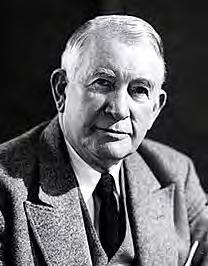
Kentucky has long been rich in leaders who have helped build and shape this country. Distinguished men and women have served in appointed and elected capacities. Perhaps, that will be the next chapter.
Franklin County was established in 1794 and named for United States founding father Benjamin Franklin.
May 2023 55
John C. Breckinridge
Happy Chandler
Alben Barkley
Stately Pillars
Green Hills, the home of James Ben Ali Haggin
By Bobbi Dawn Rightmyer, Harrodsburg
The mansion once known as the “Biltmore of Kentucky” is now remembered only by its pillared facade. Here’s the story of the man who built it and how it came to be.
Kentucky horse breeder James Ben Ali Haggin was born on Dec. 9, 1822, in Harrodsburg. He was a descendant of the early families who settled in Kentucky in 1775, counting Ibrahim Ben Ali, an early American settler of Turkish origin, as one of his ancestors. Haggin’s grandfather, John Haggin, was the founder of “Haggin’s Race Path” in Harrodsburg, one of Kentucky’s first horse racing tracks. The younger Haggin became an attorney after graduating from Centre College in Danville. He was a rancher and owner and breeder of Thoroughbred horses. His star runner, Ben Ali, was the winner of the 1886 Kentucky Derby. Today, the Ben Ali Stakes, a race run each spring at Keeneland in Lexington, is named is Haggin’s honor.

Haggin married Eliza Jane Sanders of Natchez, Mississippi, in 1846, and they had five children. In 1859, he purchased the Rancho Del Paso horse farm near Sacramento, California, which became one of America’s prominent horse breeding and Thoroughbred racing operations. Although Haggin had a successful career in the horse industry, by the 1880s, he became a multimillionaire from investing in the California Gold Rush.
Eliza Jane died in 1893, and four years later, Haggin married Margaret Pearl Voorhies. Haggin was 75 at the time, and Voorhies was 28. The wedding took place in the home of the bride’s parents in Versailles. Few were in attendance to celebrate, but The New York Times described it as “the most romantic wedding in the small community’s history.”
Haggin bought Elmendorf Farm in Lexington in 1897 and expanded the property by purchasing many of the farms surrounding it. Haggin transformed Elmendorf into
a nationally renowned stud farm with horses sporting distinguished bloodlines. It also was a dairy operation noted for its progressive practices. During the 1890s and 1900s, the 500-acre farm expanded to 13,000 acres.
After Haggin purchased Elmendorf Farm, he built a grand mansion as a wedding gift to his new wife. In March 1900, the Haggins began planning and reviewing improvements to the farm, including the new main residence. The mansion was built on a hill overlooking North Elkhorn Creek to the north and the stallion barn and training track to the west. The house was more than 12,000 square feet and built of brick and white marble. It included three stories and a full basement. A stone balustrade surrounded the roofline.
Mrs. Haggin named the mansion Green Hills because of the beautiful view of Bluegrass country. Henry L. Copeland, one of the architects who designed the mansion, stated, “The house stands upon an unusually beautiful country … a view of three counties [Fayette, Bourbon and Scott] from the front door … advantages of the eminence with its commanding outlook.”
Green Hills had 40 rooms, and its estimated construction cost was $300,000, which would translate to approximately $10 million today. To outfit the home’s interior, Haggin hired New York’s Herter Brothers— Gustave and Christian Herter—famed interior designers who catered to the affluent. They previously had designed the interior of Haggin’s brownstone on Fifth Avenue in New York City.
According to a Lexington Herald-Leader article from April 1919, the home was decorated in Louis XVI style with beautiful tapestries, splendid sculptures, frescoed paintings and decorative arts filling the ballrooms, dining rooms, entrance halls, salons and billiards rooms. One reporter wrote about Haggin’s mansion: “The whole building, exterior and interior, has the spaciousness and grandeur of some Old-World Castle.” Another reporter wrote, “I viewed Green Hills [as] an imposing gray stone

56 THE KENTUCKY EXPLORER
Singer and actress Rosemary Clooney was born in Maysville on May 23, 1928.
James Ben Ali Haggin
Green Hills at Elmendorf Farms. Photo courtesy of the University of Kentucky’s Special Collections Research Center.
pile perched high on an eminence overlooking thousands of fertile acres, hundreds of grazing Thoroughbreds, and mile upon mile of rolling Kentucky landscape.” Green Hills provided a country escape for the newlyweds.
CLASSIFIED ADS
Reach 120,000 readers with classified advertising available in Kentucky Explorer. Classified ads $50 per issue (up to 25 words). Contact Deborah Kohl Kremer at deb@kentuckymonthly.com
In 1905, Haggin stopped using Rancho Del Paso as a horse breeding farm and concentrated his breeding efforts at Elmendorf Farm. He worked to develop it into the largest horse-breeding operation of its era in the United States. He invested more than $2 million to grow the size and scope of the farm. In its heyday, Elmendorf Farm was home to 2,000 horses, including stakes winners such as Salvator and Miss Woodford.
When Haggin died in 1914, the estate was broken up. In 1929, the owner, Joseph Widener, had Green Hills demolished to avoid paying taxes on the enormous unoccupied home. Only the columns remain.


Today, the pillars stand on private land on Iron Works Pike. They are not visible from the road.
WANTED TO BUY: All types of antiques and collectables. Top prices for gold, silver and costume jewelry. Scrap gold. Gold and silver coins. Wrist and pocket watches. Collections. Early post cards and fountain pens. Civil War swords and other military items. Vintage toys. Pocket knives. Lighters. Old eye glasses. Pottery and stoneware. All types of railroad items. Advertising signs. Handmade quilts. Marbles. Jars. Much much more. Complete and partial estates. Call Clarence, buyer for more than 30 years, at 606.531.0467. (F-D)
May 2023 57
Henry County, formed in 1798, is named for statesman Patrick Henry.
The Green Hills pillars, all that remain of the great mansion today. Photo by Tom Ferry; left, a side view of Green Hills at Elmendorf Farm in 1909. Photo courtesy of University of Kentucky’s Special Collections Research Center.
by Bill Ellis
Pet Peeves: Words and Expressions
I Have Learned to Hate and Distrust
Iunderstand that the English language, “the argot of the day,” changes over time. But why did it have to change in my lifetime?
I realize I am 83 years old and way behind the times as far as American culture is concerned. I am, in fact, an old fogey.
So, it is high time I speak out against changes in the American usage of certain words and phrases.
For example, “paradigm” is especially popular now. A secondary meaning, “an example serving as a model; pattern,” is used in discussing almost anything from politics to love. Why not clearly say what the pattern apparently is without using “paradigm” to sound conclusive, beyond reproach?
“Meta” is a much-used word beyond its primary usage in science. It is even the name of a company— excuse me, a corporation. Persons use meta as a prefix to give importance to a procedure.
And then there are the irritating expressions we run into every day.
In my lifetime, “guy” has been changed from its original meaning of male or youth, to all of us. I am a guy. My wife, daughter, granddaughters and greatgranddaughters are not guys. They are wonderful females of the species.
Now almost gone, a person— usually quite young—in explaining something would end a sentence with “and stuff” without explaining fully.
However, “uptalk” is still with us, wherein a person ends a normal declarative sentence with a rise in tone of voice, as if it were a question. Added to this is the inane “ya think?”
There is mostly courtesy in sitdown restaurants, though from servers we still get the occasional “Are you working on that?” Or if you dally at a crowded restaurant, the more insistent “Are you STILL working on that?”
And then the incessant “have a good one” at the paying of a bill. Is it too much to say, “Have a good day?” When I have pointed this out to a person, he or she usually sulks.
When we thank a salesperson, we often get a sullen “No problem.” It would not do any good to point out that you did not know this was a problem because you will get an even more sullen response.
“A rose by any other name would smell as sweet,” according to William Shakespeare, but “brilliant” legislators in some states would like to change the word “slavery” to “involuntary relocation.” Figure that one out, if you can.
The word “issue” is now given a meaning that used to be “problem.” I reckon it sounds less serious. At 83, I do not have health issues. I have health problems too numerous to list here. We do not have crime issues but crime problems; we do not have issues with Vladimir Putin and Russia but problems.
“Conflated” is popular, but “blended” would sound less esoteric. Same for “per se,” meaning “by itself” in Latin, which is misused. In my student days, “esoteric” was popular as referring to knowledge limited to a small group.
If you can “wrap your mind around it,” as many people are wont to say these days, essentialized,
catastrophizing, parse and contextualizing are popular argot of the day among my field—historians.
Eastern Kentucky University education Professor Richard Day maintains that today’s kids have changed “toast” to “cheers” as in: “It’s cheers to the new house.”
“My pet peeve is the abandonment in the direction of action as the necessary element in some phrases,” Day explained. “I hear people say, ‘You need to bring your transcript to the registrar’s office.’ Rather than ‘take.’ Or ‘I can bring you to the bus station tomorrow.’ ”
Retired EKU Professor Shirley Baechtold maintained that, as soon as someone says, “I’m not prejudiced, but …” you know what follows.
State historian Jim Klotter and family dislike the usage of “like” as in “I was like …” And “In my honest opinion.” Why would it be dishonest?
These immortal words were the bane of my teaching days: “Should we be taking notes?” and “Is this going to be on the test?”
And finally, how in the world did “passed” become common in pronouncing a person dead? I passed high school English II and college English I.
When I die, would you please tell your friends that “ Bill Ellis passed away” still bemoaning the way word usage has changed with the “argot of day.”
Readers may contact Bill Ellis at editor@ kentuckymonthly.com
past tense/present tense
58 KENTUCKY MONTHLY MAY 2023
It’s Always Somethin’
Whenever my mom heard of something bad happening to somebody somewhere, she said, “It’s always somethin’.”
Rose gardeners can relate. It seems it’s always somethin’ that’s harassing roses—black spot, powdery mildew, spider mites, slugs, Japanese beetles, cold winters, late freezes, deer.
The latest “somethin’ ” rose lovers have had to battle is a devastating disease called Rose Rosette (RRD). And unlike the above-mentioned maladies, there is no remedy for RRD.
DISTORTION
RRD was first discovered in the Northwest about 80 years ago, but it wasn’t until 2011 that it was identified as a virus and the transmission was understood. RRD is spread by a tiny eriophyid mite, visible only under magnification, that favors the multiflora rose as its primary host and frequently kills them. Now, no one will need grief counseling if the multiflora roses die out, but the mite has spread from that hateful plant into our rose beds. Even the widely planted Knock Out roses, which once were touted as disease-free, fall victim to RRD.
It is important to be on the lookout for RRD among your roses. While there is no cure, removing the infected rose ASAP may spare others in the vicinity. RRD presents as distorted, bright red foliage on new growth. The emerging flower buds will appear in tight clusters, called rosettes—hence the name. They also are called “witches’ brooms.” Look for them on the top of the plants. You also will see excessive thorniness and distorted stems; the stems may be flat instead of round or thicker at the top instead of the bottom.
Be aware that roses often sport reddish or purplish new growth, and
that doesn’t mean they are infected with RRD. To determine the difference, compare the reddish foliage to the older, green foliage farther down the plant. If the leaves have the same shape and size but are just a different color, it is likely normal growth, not RRD. Also, look at the thorns. The stems of roses infected with RRD will be extremely thorny.
Herbicide injury on roses looks a lot like RRD. Herbicide injury typically presents as red, distorted foliage. A plant pathologist at the University of Kentucky told me once that the majority of roses sent to the lab for determination actually were injured by the common weed killer 2, 4-D and were not victims of RRD. So, if you or a landscape company has sprayed your yard in the vicinity of the roses (and if it’s a warm, windy day, the spray can travel a long way), what looks like RRD may be chemical injury. Only a plant lab can make a definitive diagnosis. If it’s chemical injury, the plant probably will survive.
PREVENTION
Once a rose is infected with RRD, there is no cure. The rose may survive three to five years, but you don’t want to let that happen. Remove it because it is a reservoir of disease for other roses in the vicinity.
It is best to cover the plant with a heavy-duty plastic bag before cutting it down at the base to prevent the mites from falling off and climbing back onto a nearby healthy plant. After cutting down the plant and trashing or burning it, dig up the roots and remove as much as you can. The virus cannot survive in the soil, but it can remain alive on the roots. For that reason, it is a good idea not to plant another rose in its place for at least a year or so.
Other steps you can take to prevent RRD infection:
Prune close to the ground (except some shrub and climbing roses) in late winter. This step removes any lurking mites that live near the top of the plant. Some gardeners suggest dousing the plant with horticultural oil to help smother the mites; others maintain this is not effective. Do not use leaf blowers around your rose bushes. The mite that spreads RRD cannot fly, but it is so small, it can hitch a ride on the wind. Don’t offer it a ride.
For the same reason as above, it is a good idea to plant roses away from prevailing winds. That is especially true if those winds cross stands of multiflora rose. The east side of a building is a good spot for roses because they will be out of the wind most of the time and will catch the morning sun.
Don’t plant roses too close together. The mites are slow movers that feed on the new growth of the plant. They typically move from one plant to another only when those plants touch or they are blown there. Spacing roses farther apart also helps prevent other diseases, including black spot and powdery mildew.
This last step is the most challenging: Do what you can to eliminate multiflora roses. At least try to remove those in the vicinity of your roses. Back in the early 1900s, the government, bless its heart, encouraged the planting of multiflora roses to stem erosion and provide habitat for wildlife. But the multiflora rose quickly became a pest that is here to stay. Mowing or cutting it down will only encourage more vigorous regrowth. The best tactic is to cut the stems near the ground (have fun getting close to those!) and spray the cut stem with undiluted glyphosate. Yes, it’s easier said than done.
Plant breeders are working to develop cultivars that are resistant to RRD, and they will come down the pike in a few years. We rose lovers hope so, anyway.
Meanwhile, it’s always somethin’.
by Walt Reichert gardening
Readers may contact Walt Reichert at editor@kentuckymonthly.com kentuckymonthly.com 59
by Gary Garth
Failure
On March 27, a Monday, at a little after 10 a.m., a 28-yearold individual used a firearm to shatter the exterior glass doors of The Covenant School, a private preschool through 6th grade, Presbyterian-affiliated parochial school near the Green Hills neighborhood in Nashville. The shooter then climbed through the broken doors and entered the building. Surveillance video of that entrance, released by Nashville police, can be seen on YouTube.
Gunfire shattering the school doors begins 26 seconds into the video. The perpetrator killed three 9-year-old students and three adults, including two school employees and a substitute teacher. Police arrived within minutes. The shooter died in an exchange of gunfire with officers. In the approximately 15 minutes between entering the school and the confrontation with police, the shooter fired 152 rounds.
Thoughts and prayers flowed in from Washington, D.C., and statehouses across the nation.
Fourteen days later, on April 10, another Monday, at a little after 8:30 a.m., a 25-year-old man walked into the Old National Bank at 333 East Main Street in downtown Louisville, not far from the waterfront. Armed with a rifle, he open fire. Four people, all bank employees, died in the building. A fifth victim, also a bank employee, died later at a hospital. Police arrived within minutes and, in a harrowing exchange of gunfire, killed the shooter, who also was a bank employee. Video of that exchange, released by Louisville police and edited for public viewing,
can be seen at https://abcnews.go. com/US/live-updates/active-shooterlouisville/?id=98470141. Eight people were injured, including three police officers. Officer Nickolas Wilt, 26, suffered a serious head wound. Wilt was new on the job, having graduated from the police academy on March 31. Thoughts and prayers again flowed in from Washington, D.C., and state houses across the nation.
The news from The Covenant School and the Old National Bank jarred me, but it didn’t jar me as violently as it should have. I am ashamed of this. But like you and possibly everyone else across the Commonwealth and the nation, I have become slightly numb to the news of shootings, even those involving children. It is an involuntary self-defense mechanism. This doesn’t lessen my shame but helps to control my outrage and steady my emotions.
The killings qualified as mass shootings because there were more than four victims, not counting the shooters. According to the Associated Press, The Covenant School outrage was the 15th mass shooting at a school or university in the United States since a pair of students killed 12 of their fellow students and a teacher before turning their guns on themselves at Columbine High School in Colorado in April 1999. School shootings at Kentucky’s Heath High School (1997) and Marshall County High School (2018) aren’t officially counted as mass shootings because, as horrid as they were, the death count (three at Heath and two at Marshall County, both near my home) did not reach the mass shooting minimum.
According to the Associated Press, the Old National Bank shooting was the 15th mass shooting in the United States this year. Five days after that tragic event, a shooting in Louisville’s Chickasaw Park left two dead and four wounded—not technically a mass shooting but nonetheless devastating.
It’s obscene that we must think about such things.
Mass shootings aren’t restricted to schools and banks, of course. They happen in churches, grocery stores, hospitals, nightclubs, synagogues … it’s a long list.
I have no simple solution for this ongoing, uniquely American nightmare, but it’s no secret that guns and gun rights are near the crux of the issue. I say this as a firearm owner and a proponent of gun rights. I have colleagues who say with absolute conviction that guns are not the problem. I agree. Guns in and of themselves are not the problem. But guns are part of the problem. And while in some quarters it might risk political suicide to even broach this untouchable subject, the political unwillingness to acknowledge and attempt to deal it is costing lives. And it’s intolerable. Shamefully intolerable.
I have no solution. But I am also not an elected political leader charged with helping govern the state or the nation. I do not believe that arming teachers or looking toward a good guy with a gun are any more reasonable solutions than wrapping oneself in the Second Amendment and waving the flag or erasing the Second Amendment in hopes of creating a gun-free utopia.
field notes 60 KENTUCKY MONTHLY MAY 2023
So, we must look to our political leaders for answers, which will be neither simple nor popular. Those answers will come at a political cost. But they must come because currently our elected officials are failing us. Failing our children. Failing our future. Some share more burden of the failing than others, of course, but everyone who is elected to lead, to help solve problems, to draft laws, to keep us safe is failing us. All of them. It is absolute bipartisan failure. A few of our elected folks have resorted to finger pointing and name calling. If the stakes were not so high, the consequences not so deadly, this childish, buffoonish behavior would be laughable. But it’s not laughable. I don’t care what political color you are or which, if any, political party to which you adhere. This inaction is shameful.
Will this be politically easy? No. Will it cost political careers? Possibly. Will continued inaction cost lives? Absolutely.
Blood spilled at The Covenant School, Louisville’s Old National Bank and Chickasaw Park, Heath High School in Paducah, Marshall County High School—from Sandy Hook Elementary in Connecticut to Uvalde, Texas; Parkland, Florida, to Las Vegas; and hundreds of horrific scenes splatters the political landscape and the people in the seats of power. We’re stained, too. Shame on our leaders for their inaction. Shame on us for tolerating such.
Readers may contact Gary Garth at editor@kentuckymonthly.com
SUMMER 2023
Outdoor Dinner and Show!!
June 9 - July 1
BLOOD SUEDE SHOES: A SERGEANT ELVIS PRESLEY MURDER MYSTERY
July 4 – July 22

FARCE OF NATURE
July 25 – August 12
KOSHER LUTHERANS
August 18-19
SPECIAL STAND-UP COMEDY WEEKEND STARRING LEE CRUSE
7:00 pm: Home-cooked Dinner! 8:30 pm: Live Theatre Under the Stars!

Make your reservations now!

859.236.2747
pioneerplayhouse.com
Places to stay: danvilleky.com
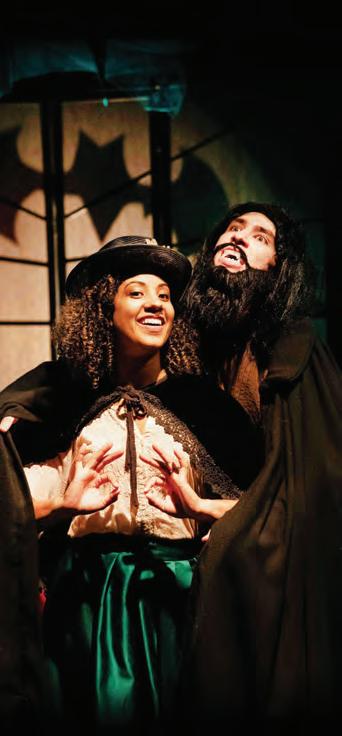 OUTDOOR THEATRE & CAMPGROUND
OUTDOOR THEATRE & CAMPGROUND
74
kentuckymonthly.com 61
2023
MAY 2023
Ongoing Larger Than Life Exhibit National Quilt Museum, Paducah, through July 11, 270.442.8856
7 First Sundays at Julietta Market, Greyline Station, Lexington, 661.388.9259
14 Mother’s Day
21 Get the Led Out Tribute Band Mountain Arts Center, Prestonsburg, 606.886.2623
28
1
2 Blues Traveler in Concert SKyPAC, Bowling Green, 270.904.1880
3
4 Circus DuBois Norton Center for the Arts, Danville, 859.236.4692
5 Kentucky Oaks, Churchill Downs, Louisville, 502.636.4506
6 Kentucky Derby, Churchill Downs, Louisville, 502.636.4506
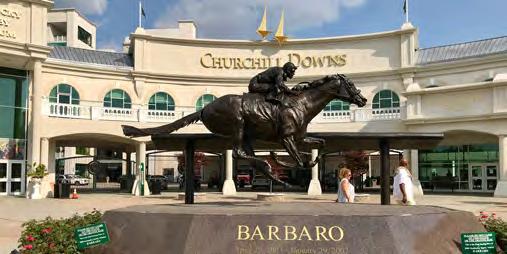
9 Morgan Wade in Concert, Mountain Arts Center, Prestonsburg, 606.886.2623
15 16 Belong to Your Place: The Wisdom of Wendell Berry, Carson Center, Paduach, 270.450.4444
22
29 Memorial Day
10 Alice Cooper in Concert, Louisville Palace, 1.800.745.3000
17
11 King Lear, Campbellsville University, through May 13, 270.789.5266
18
Alison Brown Quintet, Bluegrass Hall of Fame and Museum, Owensboro, 270.926.7891
25
Garden Photography Basics Workshop, Yew Dell Gardens, Crestwood, 502.241.4788
Ongoing Rounding the Circle: The Mary and Alfred Shands Collection, Speed Art Museum, Louisville, through Aug. 6, 502.634.2700

12 Paris Storytelling Festival, Wallace House, Paris, through May 14, 859.707.6890
19 Poorcastle Music Festival Breslin Park, Louisville, through May 21
26
The Linda Smith Band, Rough River Dam State Resort Park, Falls of Rough, 270.257.2311
Ongoing Animal Attraction Art Show, Gallery 104, LaGrange, through June 3, 502.222.3822
8 Keb’ Mo’ in Concert, Lexington Opera House, 859.233.3535 a guide to Kentucky’s most interesting events
For
13 Springfest, Perryville Battlefield, Perryville, 859.332.8631
20 Lexington Philharmonic: Bloom, Singletary Center for the Arts, Lexington, 859.233.4226
27 Great American Kites, Lu-Ray Park & Amphitheater, Central City, through May 28
Ongoing West of Ninth: Race, Reckoning and Reconciliation, Frazier History Museum, Louisville through Sept. 1, 502.753.5663
SUNDAY MONDAY TUESDAY WEDNESDAY THURSDAY FRIDAY SATURDAY
calendar
a more extensive listing of events, visit kentuckymonthly.com.
Louisville’s Churchill Downs takes center stage the first weekend in May.
62 KENTUCKY MONTHLY MAY 2023
SEE HISTORY COME TO LIFE
Carrollton, Ky
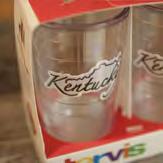




Experience what life was like during the Civil War with reenactments and immersive activities in Carrollton. History comes alive May 20TH and 21ST on the banks of the Ohio River. Stroll through the encampment and watch a skirmish! Everyone from history buffs to families will find something to entertain and delight them. Come be a part of Carrollton's Civil War living history. visitcarrolltonky.com
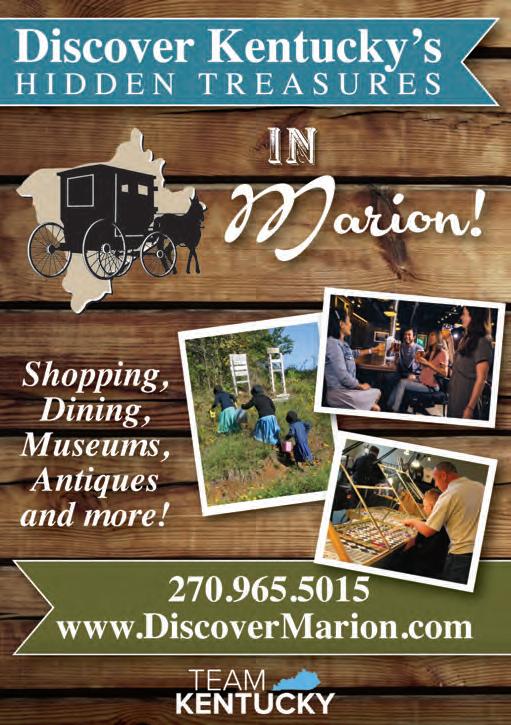

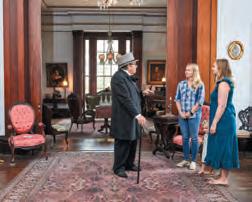



SHOP





























Plan your getaway at www.georgetownky.com | 844.863.8600 #GoToGtown #TheBirthplaceofBourbon SHOPKENTUCKYMONTHLY.COM
Kentucky inspired gifts, books, subscriptions + more!
vested interest
Boones With a View
In 1845, a well-meaning committee of Frankfort citizens traveled 370 miles to Warren County, Missouri. Against the property owner’s wishes, they disinterred pioneer Daniel Boone (1734-1820) and his wife, Rebecca (1739-1813), and brought their remains back to Kentucky.
Boone had been dead 25 years and Rebecca more than 30. “When the coffins were opened it was found that the large bones were perfect in size and shape … but so far decomposed … could not be raised in form,” the committee reported. “Their coffins were entirely rotten except for the bottom planks.”
The committee, with the remains, returned to Frankfort in August. On Sept. 13, 1845, businesses were closed for the reinterment ceremonies in the Frankfort Cemetery, which drew representatives from each Kentucky county and all surrounding states. Thousands of people, civic groups, and eight military units followed the hearse carrying the Boones’ remains, which were drawn by four white horses decorated with evergreens and flowers.
The gravesite has an unobstructed view from a high outcropping above the Kentucky River. “The river wends its way between majestic hills, and the spires of the classic old town are seen in the distance. The evergreens which stand above their last resting place constantly remind the wayfarer of the soul’s immortality, and these lofty pines above their grave, keep green the memory of the brave,” wrote the committee.
On Sunday, June 4, at 3 p.m., the Boones’ grave will be marked, commemorating the couple’s service in the American Revolution, by members of the Sons and Daughters of the American Revolution, and the public is invited.
Most of Daniel’s service was on the frontier, guarding the three significant settlements—Boonesborough (Madison County), where he lived with Rebecca and their children; Harrodsburg (Mercer County); and Logan’s Fort (Lincoln County).
He served as a colonel under Gen. George Rogers Clark, and on Aug. 19, 1782, he fought—and his son, Israel, was killed—in the Battle of Blue Licks (Robertson County). Israel was one of 72 Kentuckians killed in the battle, while the British and Native Americans lost seven.

The first Sunday in June was selected for the ceremony because it is close to Kentucky’s Boone Day (June 7), the day in 1769 when Boone first traveled through the Cumberland Gap. “I gained the summit of a commanding ridge, and, looking round with astonishing delight, beheld
the ample plains, the beauteous tracts below,” Boone said in John Filson’s 1784 Adventures of Col. Daniel Boon.
If you can’t join us on June 4 in Frankfort, the 2023 Daniel Boone Pioneer Festival is Sept. 2-3 in Winchester, and the 75th annual Daniel Boone Festival is Oct. 1-7 in Barbourville.
Many people know Boone from the television series starring Fess Parker, which aired from 1964-70. He was, according to the theme song, “a man. Yes, a big man. With an eye like an eagle and as tall as a mountain was he.”
Not true. Most historians say Boone was maybe 5-foot6, and the Shawnee called him “Sheltowee” because his backpack made him look like a turtle.
I’m a Jeopardy! Junkie, but some nights it drives me crazy. One such evening was April 12, when Liz Jensen from New Jersey answered, “What is ‘Old Kentucky Home?’ ”

“Nope,” said host Ken Jennings. “We needed a ‘my.’ ”
Starting Double Jeopardy! with only $800, Liz trailed Ben Chan, a philosophy professor from Wisconsin, by $9,200. But she went on a run and was within reach of preventing Chan from turning it into a runaway. It was $22,000 to $8,800 when she uncovered the answer, “Locust Grove in Louisville, where Lewis & Clark and John James Audubon stayed as guests, could be called this, the state song.”
What first annoyed me was that in the Jeopardy! Round, a category paired bands that appeared at Woodstock with food items. To the answer, “Bowzer and his doowop chips—I mean chaps, now covered with gooey cheese and salsa.”
Contestant Peter Early from New Hampshire timidly said, “Shan-nachos-nah.” Jennings responded, “We’ll accept that. We were looking for Shan-nah-nachos but can’t be too strict.”
Either be strict or not, but be consistent. Quickly, Eric U. chimed in on the Jeopardy! website, “I do feel for Liz on the ‘My Old Kentucky Home’ clue, as the first part seems almost designed to bait a contestant into omitting the ‘my.’ ”
Locust Grove was the home of General Clark and the explorer William Clark’s sister, Lucy, and we all know—or should know—My Old Kentucky Home is Federal Hill, U.S. Sen. John Rowan’s plantation in Bardstown.
So, here’s my problem: While Locust Grove or any of our homes could be called My Old Kentucky Home, it’s not!
Kwiz Answers: 1. B. Mutton is the key ingredient in Moonlite Bar-B-Q’s signature sandwich; 2. C. Benedictine was created by Jennie Carter Benedict, a caterer and household editor of Louisville’s Courier-Journal; 3. A. Schmidt created the open-face turkey, bacon and tomato sandwich covered with Mornay sauce in 1926 at the Brown Hotel; 4. C. Apple Stack Cake gets its name from the apple filling poured between the layers to hold them together; 5. B. Owned by the Kern family, the Melrose Inn was where Leaudra and Walter Kern, along with son George, created the first Derby Pie® in 1954 using a secret recipe still kept under wraps today; 6. B. Burgoo dates to the early 1700s; 7. C. Berea is known as the Spoonbread Capital; 8. B. Winchester is named after the Virginia hometown of Rebecca Boone and Patsy Cline; 9. A. Tender yeast bread freshly baked from scratch overflows from a seasoned clay flowerpot; 10. C. Earning praise from James Beard, Newsom’s hams are aged the way the will indicated they should be.
• • •
• • •
64 KENTUCKY MONTHLY MAY 2023
STEPHEN M. VEST Publisher + Editor-in-Chief



Come visit Kentucky’s newest small town. With plenty to do, try, taste and experience, it’s like nothing you’ve seen before! April 28 Cottages Opening Celebration April 30 Farmers’ Market Opens* *Every Sunday through November 12 May 5 Derby Eve at the Cottages May 20-21 Art Festival May 27 Music by the Water June 24 Cars in the Commons July 22 Music by the Water August 19 Music by the Water Event times and details are subject to change. Check nortoncommons.com/ events for the most up-to-date event information. May 20 & 21, 2023 • 11 am-5 pm • North Village Town Square 6324 River Beauty Loop • 502.412.5085 • www.nortoncommons.com/events Art Festival Arts & Crafts • Entertainment • Food & Drink



 Anna’s Greek Restaurant, Bowling Green
Anna’s Greek Restaurant, Bowling Green














 by Laura Younkin
by Laura Younkin































 Lexington Mayor Linda Gorton
Lexington Mayor Linda Gorton
 Mike Graves, WUKY-FM “Rock-n-Roots” host
Mike Graves, WUKY-FM “Rock-n-Roots” host





















































































































 By Mikael Levin, Bellport, New York mikaellevin.com
By Mikael Levin, Bellport, New York mikaellevin.com





















 OUTDOOR THEATRE & CAMPGROUND
OUTDOOR THEATRE & CAMPGROUND

































